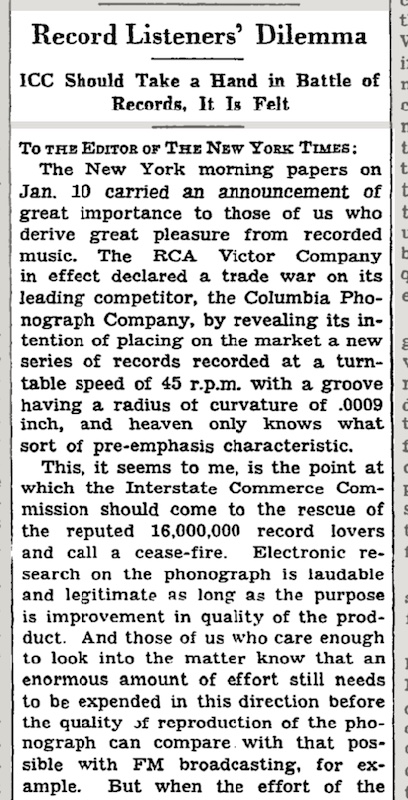EQカーブの歴史、ディスク録音の歴史を学ぶ本シリーズ。前回 Pt.12 では、Columbia Long Playing Microgroove レコードにまつわる関係者インタビューなど追加情報、および、LP開発の基盤となった技術面、そして当時の(放送局用)再生機器の補正回路などをみてきました。
On the previous part 12, I studied more on the history of the Columbia Long Playing Microgroove Records, by reading additional interviews with CBS/Columbia’s executives and engineers; technical aspects of the microgroove technology; and compensating circuits for professional broadcast reproducing equipment.
今回の Pt.13 はその続きで、Columbia LP 登場の約半年後にライバル RCA Victor から登場した 45回転マイクログルーヴ盤のエピソードと技術的側面を、当時の技術論文や技術解説記事から読み解いていくことにします。
This time as Pt.13, I am going to continue learning the history of disc recording — the advent of 45 rpm microgroove records by RCA Victor — introduced about half a year after Columbia unveiled LP records, as well as the technical aspects of RCA Victor’s new system, by reading and interpreting the technical papers and articles at that time.
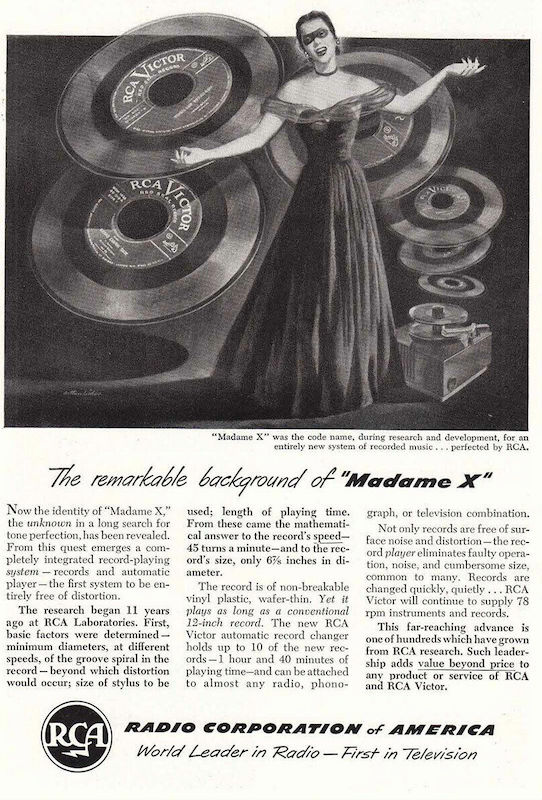
RCA Victor “Madame X” Ad
source: HAGLEY DIGITAL ARCHIVES
- 「Pt.0 (はじめに)」
- 「Pt.1 (定速度と定振幅、電気録音黎明期)」
- 「Pt.2 (世界初の電気録音、Brunswick Light-ray、ラジオ業界の脅威)」
- 「Pt.3 (Blumlein システム、当時のRCAやColumbia、民生用における高域プリファレンスの萌芽)」
- 「Pt.4 (Vitaphone、Program Transcription、Electrical Transcription、Bell Labs / Western Electric 縦振動トランスクリプション盤)」
- 「Pt.5 (ベル研とストコフスキーのエピソード、横振動トランスクリプション、Orthacousticカーブ)」
- 「Pt.6 (アセテート録音機のカッターヘッド特性、高調波歪の論文、超軽量ピックアップ)」
- 「Pt.7 (圧電ピックアップとジュークボックス、定速度記録再生の試み)」
- 「Pt.8 (1942年 NAB 標準規格策定の歴史)」
- 「Pt.9 (大戦中〜戦後、LP登場前夜の状況について)」
- 「Pt.10 (1949年 NAB 標準規格策定の歴史)」
- 「Pt.11 (1948年6月18日 Columbia LP Microgroove レコード登場)」
- 「Pt.12 (Columbia LP の技術的背景)」
の続きです。
This article is a sequel to
- “Things I learned on Phono EQ curves, Pt.0 (Intro)”,
- “Pt.1 (constant velocity/amplitude, early years of electrical disc recording)”,
- “Pt.2 (earliest electrical recordings, Brunswick Light-ray, Radio industry)”,
- “Pt.3 (Blumlein system, RCA and Columbia in the early 1930s, germination of treble pre-emphasis)”,
- “Pt.4 (Vitaphone, Program Transcription, Electrical Transcriptions, Bell/WE Vertical Transcription)”,
- “Pt.5 (Bell Labs = Stokowski episode, Lateral Transcription and Orthacoustic)”,
- “Pt.6 (Instantaneous Recorders, papers on distortion and lightweight pickup)”,
- “Pt.7 (piezo-electric pickups, jukebox, constant-amplitude recording)”,
- “Pt.8 (history of 1942 NAB Standards)”,
- “Pt.9 (various situations in the 1940s)”,
- “Pt.10 (history of 1949 NAB Standards)”,
- “Pt.11 (Jun. 18, 1948: the advent of Columbia Long Playing Microgroove Records)”,
- and “Pt.12 (technical background of Columbia LP records)”.
毎回書いている通り、筆者自身の学習過程を記したものですので、間違いの指摘や異論は遠慮なくお寄せください。
As I noted in every part of my article, this is a series of the footsteps of my own learning process, so please let me know if you find any mistakes on my article(s) / if you have different opinions.
今回も相当長い文章になってしまいましたので、さきに要約を掲載します。同じ内容は最後の まとめ にも掲載しています。
Again, this article become very lengthy — so here is the summary of this article (the same contents are avilable also in the the summary subsection).
1949年1月9日、Columbia が 33 1/3回転かつ7インチの新メディアを発表。翌日の1月10日には RCA Victor が開発コードネーム「Madame X」、45回転7インチの新メディアと専用オートチェンジャーを発表。ともに従来の10インチ/12インチシェラック盤の代替を目指したメディアであった。7インチ/10インチ/12インチ 33 1/3回転の Columbia LP と、7インチ45回転盤との間で「回転数競争」の幕が切って落とされた。
On January 9, 1949, Columbia introduced another new format — 7-inch 33 1/3 rpm record. On the next day (January 10), RCA Victor officially unveiled its new format, 7-inch 45 rpm record and record changer system, code-named “Madame X”. This was the start of “Battle of the Speeds”, between Columbia’s 33 1/3 rpm (7/10/12-inches) and RCA Victor’s 45 rpm (7 inch).
7インチ盤は、長時間再生を犠牲にした代わりに、コンパクトなオートチェンジャーにより迅速な連続再生を売りにした。また大きなセンタースピンドルにより、内側からレコードを支えられる(結果、オートチェンジャー自体の寸法が小さくできる)メリット、そして盤に使用するヴァイナル化合物を減らせ廉価に製造可能なメリットがうたわれた。
RCA Victor’s 7-incher gave up long-playing feature, while it enabled continuous playing with compact auto-changer machines. Use of large spindle holes enabled the changer machine to hold the stacked records inside the spindle (thus the changer being compact); also the use of large spindle holes was for reducing raw material cost of pressing records.
結局、1950年4月には RCA Victor が 33 1/3回転長時間盤をリリース、1950年8月には Columbia が 45回転盤をリリースし、2種類のメディアが棲み分けることで落ち着いた。その後、7インチLPは1951年にフェードアウトし、45回転アルバムも1950年代半ばにはフェードアウトした。
The battle between two companies finally settled down after RCA Victor started releasing 33 1/3 rpm long playing records in April 1950 and Columbia started releasing 45 rpm singles in August 1950. Then Columbia’s 7-inch LP faded out in 1951; 45 rpm albums also faded out around mid-1950s.
RCA Victor が 45回転盤用に使用した録音特性(録音EQカーブ)は、のちの New Orthophonic(すなわち RIAA)に近いが、低域ブーストがなく、7〜8,000Hz より上はローパスフィルタで減衰されているというものだった。これは RCA Victor が当時 78回転盤向けに使っていたカーブと同じであった。
The recording characteristic (recording EQ curve) for RCA Victor’s 45 rpm records is so-called “Old Orthophonic”, which is basically similar to “New Orthophonic” (= RIAA), except it lacks the boost in the low-bass region, and high-frequency low-pass filter (about 7~8,000Hz and above) is applied. This characteristic was the same as the one used for RCA Victor’s 78rpm records at the time.
Contents / 目次
- 13.1 Advent of RCA Victor “Madame X” 45rpm Microgroove Records
- 13.1.1 The Billboard, December 4, 1948: “On and Off the Soapbox”
- 13.1.2 The Billboard, January 8, 1949: “Lowdown On New RCA Disk”
- 13.1.3 The Billboard, January 8, 1949: “Columbia’s New 7-Incher”
- 13.1.4 The New York Times, Monday, January 10, 1949: “Trade War Traps Record Buyers”
- 13.1.5 The New York Times, Tuesday, January 11, 1949: “RCA-Victor Unveils New Disks”
- 13.1.6 The New York Times, Monday, January 17, 1949: “Record Listeners’ Dilemma”
- 13.1.7 Armistice and Aftermath of the “Battle”
- 13.1.8 … so what happened to “Columbia’s 7-inch 33 1/3 rpm records”?
- 13.2 Technological Background of RCA Victor 45rpm records
- 13.2.4 RCA Victor Record Changers
- 13.4 The summary of what I got this time / 自分なりのまとめ
13.1 Advent of RCA Victor “Madame X” 45rpm Microgroove Records
1948年6月18日、Columbia LP のお披露目(Pt.11 参照)から約半年後、沈黙を貫いてきたライバル RCA Victor が、45回転、7インチ(正確には 6⅞ インチ)盤、という新メディアを発表しました。1949年1月10日のことでした。
About half a year after Columbia unveiled the Long Playing Microgroove records on June 18, 1948, the rival RCA Victor unveiled its new format — 45 rpm, 7 inch (more precisely 6⅞ inch) disc — which is different from Columbia’s LP. It was unveiled on January 10, 1949.
しかし、突如発表が行われた、というよりは、1948年暮れ頃から業界内で噂が飛び交い、公式発表を待つ、といった状況だったようです。
But the official announcement was NOT unveiled suddenly. The truth was that the rumor was circulated in the industry at the end of the year 1948, and everybody waiting for the official announcment of the new format.
「From Tin Foil to Stereo: Evolution of the Phonograph」(Read & Welch) には、このような記載もあります。
Also in the famous book “From Tin Foil to Stereo: Evolution of the Phonograph” (by Read & Welch), it reads:
Moreover, within a month after the announcement, rumors began to be circulated in the trade circles that a certain large company was about to issue a new disc and record-playing equipment, to have a turntable speed of 40 plus rpm, but that it was not to be a microgroove, as the Columbia groove had been called by its inventors. It is interesting to note that this rumor began to be circulated after a number of other recording companies had signified their intention to make use of Columbia’s microgroove system under a licensing arrangement.
しかも、この(Columbia LP の)発表から1ヶ月も経たないうちに、とある噂が業界内を駆け巡り出した。曰く、「ある大企業が、回転速度を40数回転にした新しいレコードとプレーヤを発表しようとしている」「ただし、それは Columbia LP の発明者が呼ぶところのマイクログルーヴではない」というものであった。興味深いのは、この噂が流れ出したのは、コロムビアのマイクログルーヴシステムを他のレコード会社がライセンス契約により使用する意向を示した直後であったことである。
“From Tin Foil To Stereo” (Read & Welch, 1959), p.34013.1.1 The Billboard, December 4, 1948: “On and Off the Soapbox”
私が探せた範囲内で、この新メディア登場の噂に関する記事を掲載した最初期の例は、The Billboard 1948年12月4日号です。この記事は以前 「EP」(Extended Playing) という用語の語源を調べた記事 でも紹介しました。
One of the earliest news articles (among what I could have found so far) on the rumor of RCA’s new disc format is found on December 4, 1948 issue of The Billboard magazine. I previously mentioned in this news article on the origin of the term “EP” (Extended Playing).
この記事を書いた Joe Csida という記者はどうやら、Columbia LP に始まる新メディア登場をきっかけに、当時著名だった週刊誌 Saturday Review of Literature 上に掲載されていた、根拠のない噂話レベルの(音楽ファンやレコードコレクターを混乱に陥れるレーベル達に物申す、的な)記事群を受け、執筆時点で明らかになっていることを書き殴ったようです。とはいえ、この記事自体も噂話レベルでしかないわけですが(笑)
The author of this particular article, named Joe Csida, probably scribbled something in his mind against several “baseless” gossip articles of junk — like complaining to record labels that throws music lovers and record collectors into disarray — especially the ones frequently published in such famous weekly magazines as Saturday Review of Literature. On the other hand, this Csida’s article itself also looks like a gossip article 🙂
ちなみに、ここで名前があがっている Edward Tatnall Canby 氏と Irving Kolodin 氏は、ともにいわゆる「音楽評論家」で、特に前者は Audio Engineering 誌の「Record Review」欄を担当していたことでも知られています。
By the way, the writers that Csida points a spear at are Edward Tatnall Canby and Irving Kolodin: both are so-called “music critique”, and especially the former (Canby) was famous as a person in charge of “Record Review” corner on the Audio Engineering monthly magazine.
(…) We hesitate to do battle with a couple of literary characters like Edward Tatnall and Kolodin, who write so learnedly of matters about which they know so little, but there are a few items which should be pointed out.
(..前略…) 実はほとんど知らない事柄をいかにも博識ぶって書く Edward Tatnall Canby や Irving Kolodin といった文筆家を相手にするのは躊躇われるところだが、、現時点において指摘できる点がいくつかあるのも事実である。
(1) Columbia put out its long-playing microgroove 33 1/3 r.p.m. record because its executives felt they had a product better than they had ever offered the public before at a good price. Columbia is continuing to put out 78 r.p.m. records so that the public’s present phonographs are not obsolete.
(1) Columbia が長時間マイクログルーヴ33 1/3回転盤を出したのは、過去にないほど優れた製品が手頃な価格で提供可能と同社が判断したからである。また Columbia は引き続き78回転盤のリリースを続け、大衆が現在所有する電蓄が無駄にならないようにする。
(2) RCA Victor is not going to put out 33 1/3. The company is going to put out a 45 r.p.m. record with no long-playing feature whatsover, obviously because they believe they have a better product than either the standard 78 r.p.m. records or Columbia’s 33 1/3 r.p.m. RCA Victor is also going to continue to put out its regular 78 r.p.m. records, so that here again the public’s present phonographs will not be obsolete. RCA Victor is not making public its new-type records because they want to give dealers every opportunity to get all the business to be had during the Christmas season. The executives are fully aware that there is much speculation and that typewriter titans like Canby, Kolodin and Csida will write whatever they believe they should write anyway, and that Canby, Kolodin and Csida combined don’t have enough circulation to make a dent in the consumer field anything approximating the dent an official RCA Victor announcement to the general press would make. Thus, the confusion, on the consumer level at least, which is inherent in basic change will be held to a minimum at the time.
(2) RCA Victor が 33 1/3回転盤を出す予定はない。代わりに長時間再生機能のない45回転レコードを出す予定であり、同社は従来の78回転盤や Columbia の 33 1/3回転盤よりも優れていると信じているのは明白だ。また同社は引き続き従来の78回転盤のリリースを継続し、大衆が現在所有する電蓄が無駄にならないようにする。RCA Victor が新タイプのレコードをまだ公表しないのは、販売店にクリスマス商戦の機会を与えるためである。(RCA Victor の)経営陣は、Canby や Kolodin そして Csida(私)のようなタイプライターの巨頭どもが書くべきと思ったことはすぐに書いてしまうことも承知しているし、またこの3人を合わせたとしても、RCA Victor の公式発表による影響にかなうはずないことも承知している。よって、少なくとも消費者レベルでは、基本的な変更につきものの混乱は最小限にとどめられるであろう。
(3) RCA Victor is obviously going to produce, promote and market players on which its new 45 r.p.m. records may be played. Several other set manufacturers will probably also produce such players.
(3) RCA Victor は間違いなく新型45回転レコードの再生用プレーヤを製造販売しプロモーションを行うだろう。オーディオ機器メーカ他社もおそらくそのようなプレーヤを製造することになるだろう。
On and Off the Soapbox; Or, Some Random Thoughts Re the Record Evolution, The Billboard, December 4, 1948, pp.4,22結局、この記者自身も自嘲気味に書いているわけですが、1948年12月4日時点で、すでにRCA Victor 45回転盤登場の噂が飛び交っていたことはわかります。
After all, Mr. Csida himself writes down this article with a touch of self-derision. Anyway, as of December 4, 1948, the rumor of RCA Victor planning to release 45 rpm records was already circulated.
ご存知の通り、アメリカにおいては、多くのレーベルが1956年〜1957年あたりで78回転の新譜リリースを終了することになります。つまり、旧メディア(78回転盤)から新メディア(33 1/3回転盤および45回転盤)への移行は、おおよそ9年ほどかかったことになりますね。
As you may know, most of the record labels in the U.S. had discontinued 78 rpm releases until 1956 or 1957. So it took about nine years to finish the transition from the old format (78 rpm) to the new format (33 1/3 and 45 rpms).
13.1.2 The Billboard, January 8, 1949: “Lowdown On New RCA Disk”
The Billboard 1949年1月8日号には、同じく Joe Csida 氏執筆の1月1日付の記事として、RCA Victor が発表予定の新フォーマットについて現時点で分かっていることが掲載されています。全体の引用および拙訳は割愛しますが、その内容は RCA Victor 側から The Billboard 記者に意図的にリークされた正確な内容と思われます。
The top page of January 8, 1949 issue of The Billboard has the article by Joe Csida, reporting the facts concerning RCA Victor’s forthcoming new format. Quoting the article (and my translation into Japanese) is omitted here, but anyway it seems that the article was written based on the correct information RCA intentionally disclosured to The Billboard writer.
ただ、一箇所だけ興味深い記述があるので引用します。RCA Victor が新メディアの呼称に悩んでいるというものです。
One interesting paragraphs I would like to quote from the article — “No Name Yet” for the new 45 rpm records.
No Name Yet
名前はまだない
A tricky problem facing the RCA-ites is how to identify the new disk and player when it is finally introduced. Since Columbia has been doing an all-out job publicizing and promotiong the 45-minute aspect of its long-playing microgrooved disks, the RCA gang, it was learned, want to duck the confusion which would result from their introduction of a 45-revolutions-per-minute disk. Around Camden the project has long been referred to as the “Madame X,” but the feeling higher up is that this would hardly be in keeping with the company’s dignity on a consumer level. One plan being mulled, The Billboard learned, is to have the public name the new product via a gigantic contest.
RCA スタッフが直面している厄介な問題は、新型のディスクとプレーヤが最終的に導入された暁に、この新しいシステムをどのように呼ぶか、というものである。 Columbia がマイクログルーヴによる45分間再生可能な長時間レコードの宣伝とプロモーションに余念がないことから、RCA も45回転盤導入後の混乱を避けたいと考えていると聞いた。(RCA 本部のある)Camden の周辺では、このプロジェクトは長らく「Madame X」と呼ばれてきたが、この名前では消費者レベルで会社の品格を保つことはできない、と上層部が考えているようである。弊紙の得た情報によれば、巨大なコンテストを開催し、一般消費者から新製品の名前を募るというプランも検討されているようである。
“Lowdown on RCA New Disk: Changer Is Heart of New Player Unit”, The Billboard, January 8, 1949, pp.3,13,83-84結局、Columbia の「LP」に対し、RCA Victor は「45」を通称として使うことにしたようです。
After all, RCA Victor simply used “45” for its name, against Columbia’s “LP”.
13.1.3 The Billboard, January 8, 1949: “Columbia’s New 7-Incher”
このように RCA Victor による新メディア登場の噂が高まると同時に、Columbia の新メディア登場の噂も流れます。同じ号、The Billboard 1949年1月8日号に掲載された、1月1日付の記事「Columbia’s New 7-Incher, To Expand Its 33 1/3 Line Across Board, Is Due Soon」(33 1/3回転を全面展開するべくコロムビアの新しい7インチ盤がまもなく登場)で、Columbia が 7インチ 33 1/3 回転盤をまもなくリリースする、と紹介されています。これもまた、以前 「EP」(Extended Playing) という用語の語源を調べた記事 で紹介した通りです。
Along with the rumor of the coming new disk format by RCA Victor, another rumor began circulating about Columbia’s new disk format. In the same issue (Jan. 8, 1949) of The Billboard, there is an article entitled “Columbia’s New 7-Incher, To Expand Its 33 1/3 Line Across Board, Is Due Soon”. (See also: my 11-yrs-old article of the origin of the term “EP”)
Columbia toppers also refused to comment on the date on which they would actually introduce their new seven-inch platter to the commercial market, but the best guess is that the introduction of the RCA Victor 45 r.p.m. record would have some bearing on any decisions on timing.
また、Columbia 上層部はこの新型7インチ盤を市場に導入する時期についてコメントを避けたが、推測するに、RCA Victor の 45回転レコードの登場が、導入時期の決定になんらかの影響を与えるであろう。
More details on the Columbia seven-incher will be forthcoming next week.
この Columbia 7インチ盤に関する詳細は、来週号でお伝えする予定である。
“Columbia's New 7-Incher, To Expand Its 33 ⅓ Line Across Board, Is Due Soon”, The Billboard, January 8, 1949, p.1313.1.4 The New York Times, Monday, January 10, 1949: “Trade War Traps Record Buyers”
そして、RCA Victor による正式お披露目の前日に新メディアに言及したのは、The New York Times 1949年1月10日号でした。まずはこの記事を追ってみましょう。
The earliest article I could find so far, just on the advent of another new media from RCA Victor, was Jan. 10, 1949 issue of The New York Times. Let’s take a quick look.
1949年1月9日、まず Columbia が新メディアを発表します。1948年6月18日にお披露目された Columbia LP (Long Playing) Microgroove レコードは、10インチ盤と12インチ盤でしたが、従来のシェラック盤(78回転、10インチと12インチ)の代替メディアとして、クラシックの小品向けやポピュラー音楽向けに、7インチ盤をお披露目しました。基本技術は既にリリースされていた10インチ盤や12インチ盤と全く同じで、レコードサイズのみ小さくなったものです。
On January 9, 1949, Columbia unveiled an additional disc format — 7-inch 33 1/3 rpm “microgroove” record. It was intended to replace the conventional (at the time) shellac 78 rpm records — both 10- and 12-inch — for shorter classical pieces and popular music. The basic technology of the new format is the same as that of Long Playing Microgroove records (10- and 12-inch) — only the diameter is shrinked to 7-inch.
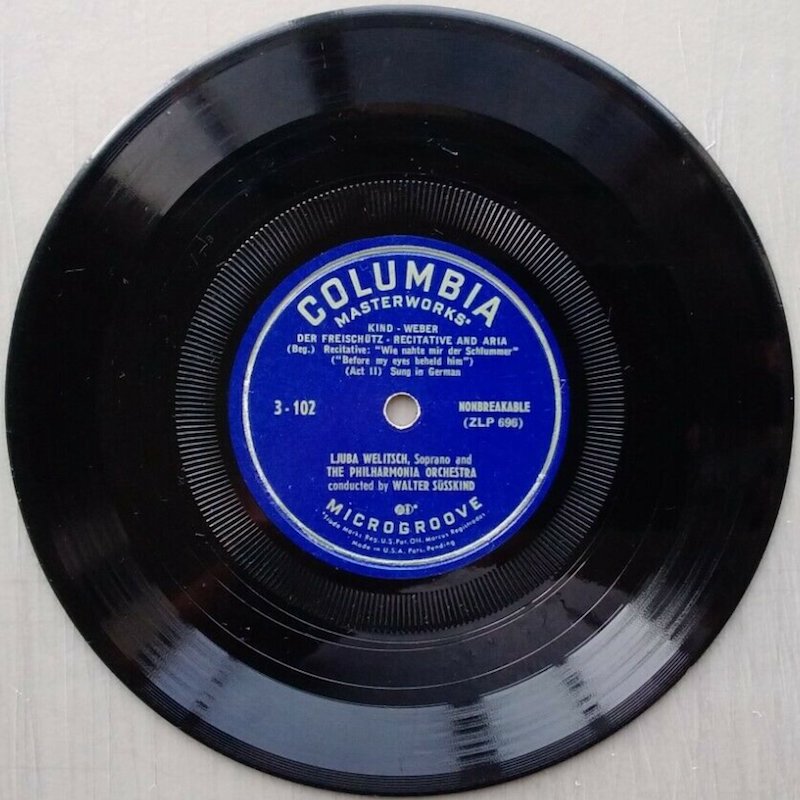
Example of Columbia 7-inch 33 1/3 rpm Microgroove Records
source: eBay listing by debbie6438
翌日、The New York Times の1949年1月10日号が Columbia 7インチ盤を1面で伝えますが、同時にライバルの RCA Victor が当日午後に別の新メディアを発表予定である、とも書かれています。
On the next day January 10, 1949, The New York Times reported on the front page, while it also reported that RCA Victor was going to announce something new that afternoon.
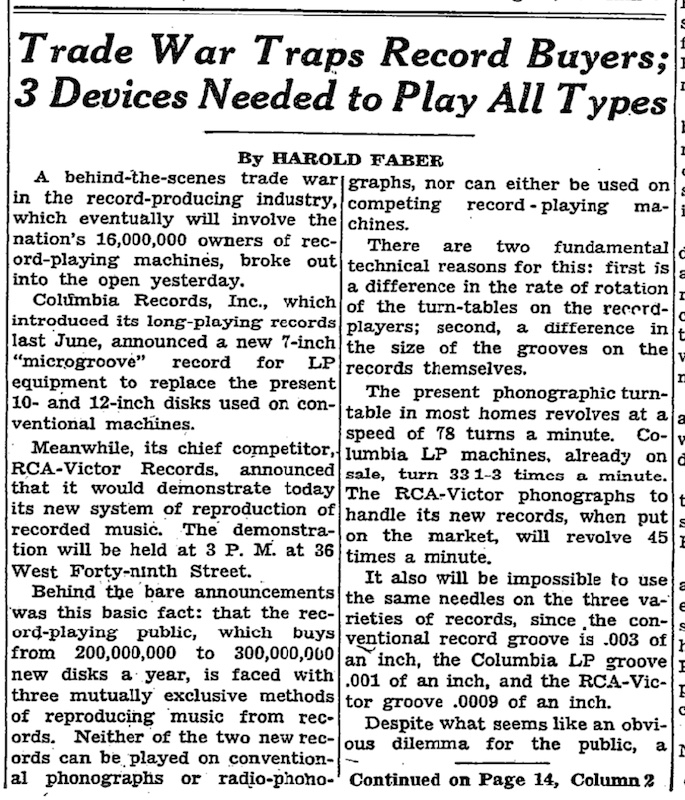
“Trade War Traps Record Buyers; 3 Devices Needed to Play All Types”, by Harold Faber
source: The New York Times, Monday, January 10, 1949, p.1.
A behind-the-scenes trade war in the record-producing industry, which eventually will involve the nation’s 16,000,000 owners of record-playing machines, broke out into the open yesterday.
レコード製造業界における水面下での商業戦争が昨日、表舞台に姿を現した。これにより、レコード再生装置を所有する全国1600万人が巻き込まれることになる。
Columbia Records, Inc., which introduced its long-playing records last June, announced a new 7-inch “microgroove” record for LP equipment to replace the present 10- and 12-inch disks used on conventional machines.
Columbia Records 社は、昨年6月に長時間レコードをお披露目したが、今度は新しい7インチの「マイクログルーヴ」レコードをアナウンスした。この盤は、LP用機器で再生可能であり、従来の蓄音機で使用されてきた10インチおよび12インチの盤を置き換えるためのものである。
Meanwhile, its chief competitor, RCA-Victor records, announced that it would demonstrate today its new system of reproduction of recorded music. The demonstration will be held at 3 P.M. at 36 West Forty-ninth Street.
一方では、Columbia のライバルである RCA Victor 社が、自社製の新たな音楽再生システムのデモを行うとアナウンスした。デモは本日午後3時より、36 West 49th St.(にある RCA の展示会場)で行われる予定である。
Trade War Traps Record Buysers; 3 Devices Needed to Play All Types, The New York Times, Monday, January 10, 1949, pp.1 & 14つまり、Columbia が 7インチ 33 1/3回転盤を発表した翌日、タイミングを合わせたかのように、RCA Victor が新しい 7インチ 45回転盤を発表したようにみえます。しかし実際は、クリスマス商戦をあえて外して1月に発表することにした RCA Victor の出鼻をくじくべく、Columbia が前日に新しい7インチ 33 1/3回転盤の発表をぶつけてきた、ということなのかもしれません。まさに「業界戦争」の様相です。
So it looks like RCA Victor was going to demonstrate its new 7-inch 45 rpm system, on the next day Columbia unvailed its new 7-inch 33 1/3 rpm records, like “igniting the battle of the speeds”. But it can also be seen as: “Columbia ignited the battle of the speeds, by demonstrating is new 7-inch 33 1/3 rpm records on the day before RCA Victor was to demonstrate its 7-inch 45 rpm system” — it was a “trade war” or “battle of the speeds” indeed.
本稿では全体引用を割愛しますが、一箇所だけ興味深い記述を。
I will not quote the entire article here, but there’s one interesting paragraph:
It also will be impossible to use the same needles on the three varieties of records, since the conventional record groove is .003 of an inch, the Columbia LP groove .001 of an inch, and the RCA-Victor groove .0009 of an inch.
また、3種類のレコード(78回転盤、Columbia LP、RCA Victor 45回転盤)では、同じ針を使うのも不可能である。なぜなら、従来のレコードの溝は 0.003インチであり、Columbia LP の溝は 0.001インチ、そして RCA Victor の溝は 0.0009インチだからである。
Trade War Traps Record Buysers; 3 Devices Needed to Play All Types, The New York Times, Monday, January 10, 1949, pp.1 & 14もちろん、これらの値は溝の幅ではなく、溝をトレースする針先の曲率半径ですから、記事が間違っているわけですが。仕方ないですよね、まだ公式発表前の噂話ですし、専門誌でなく一般紙ですから。
Of course, this paragraph is not correct — these values are not for groove widths, but for stylus tip radius. It couldn’t be helped to occur such a mistake, because the 45 rpm system was NOT yet officially announced nor released at the time (and The New York Times is not a specialized tech magazine).
それはさておき、こんにち(いや、1950年代からずっと)我々は、33 1/3回転LP盤であっても、45回転シングル盤であっても、針のサイズを交換することはありません。しかし、この1949年1月10日、45回転盤公式発表の日の朝の記事の時点では、0.001インチ用の溝と 0.0009インチ用の溝との間には互換性がなく、それぞれ別の針を使わないといけない、と受け取られかねない書き方になってしまっています。RCA Victor が意図的に Columbia LP 用曲率半径の 0.001 と異なる数字をリークしていたのかもしれませんが。
That aside, up to the present (or always since the 1950s) we don’t change the size of the tracing stylus when playing 33 1/3 LPs and 45 singles. But in this article that published in the morning of RCA Victor’s official announcement day, this paragraph may be misleading — like the 0.001 radius stylus cannot be used with the records cut for the 0.0009 radius stylus. One hypothesis is that RCA Victor intentionally leaked the value of 0.0009, which is different from 0.001 for Columbia LP records.
ともあれ、Columbia の発表、RCA Victor が発表前に語った内容、をそれぞれ簡潔に解説した本記事は、最後にこう締めくくっています。
Anyway, after a brief summary of what Columbia had announced, and of what RCA Victor spoked before the demonstration, this article ends up with the following paragraphs:
A spokesman for Columbia said the new records would go on sale before the end of this month. A representative of RCA-Victor said although his company’s new records would be demonstrated today, they probably would not be sold before spring.
Columbia の広報担当者は、この新フォーマットは今月末までに販売開始されるだろうと述べた。一方 RCA Victor は、同社の新フォーマットは本日デモを行うが、おそらく春までに販売されることはないだろう、と述べた。
Both companies said they planned to continue to manufacture their conventional shellac records. In addition, they reported that radio and phonograph manufacturers were now or would in the future produce combination to play both the standard and new records.
両社とも、従来のシェラック盤の製造は継続する予定であるという。加えて、ラジオ電蓄製造メーカが従来のレコードと新型のレコードの両方を再生できる機器を現在製造中、または近い将来に製造予定である、と両者とも報告した。
Thus, before long, the consumer will face, not only three types of records, but three record-playing machines: one that revolves at 78 rpm, one at 33 1-3 and 78 rpm, and one at 45 and 78 rpm.
従って、近いうちに消費者は、3種類のレコードだけではなく、78回転の再生装置、33 1/3回転+78回転の再生装置、45回転+78回転の再生装置、と、3種類の再生装置と向き合うことになるのだ。
Trade War Traps Record Buysers; 3 Devices Needed to Play All Types, The New York Times, Monday, January 10, 1949, pp.1 & 1413.1.5 The New York Times, Tuesday, January 11, 1949: “RCA-Victor Unveils New Disks”
そして翌日の同紙で、RCA Victor が 1949年1月10日にプレス向けに発表した内容が報告されています。一般紙ですので、一般大衆目線で書かれています。
Then the next issue (January 11, 1949) reports the RCA Victor’s demonstration on January 10. As New York Times is a general newspaper, the article is written from general public’s point of view.
そして初めて、Columbia の 7インチ 33 1/3回転盤、RCA Victor の 7インチ 45回転盤、両者の写真がお披露目されています。
And for the first time ever, pictures of Columbia’s 7-inch 33 1/3 rpm records and RCA Victor’s 7-inch 45 rpm records are published here.
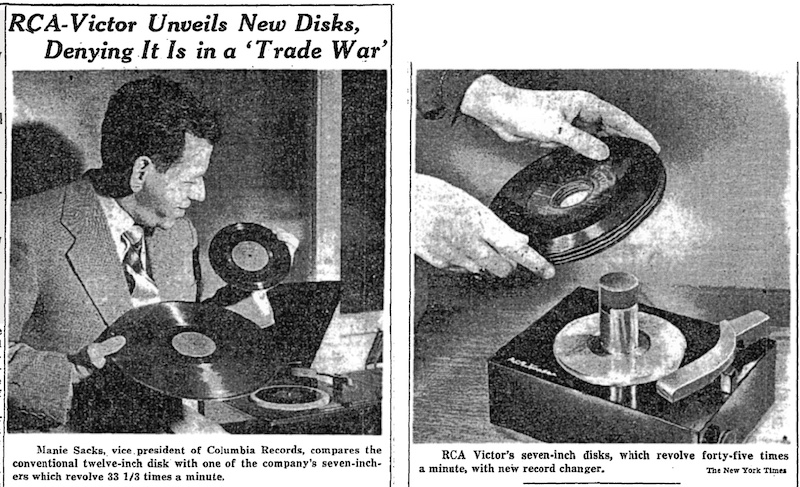
“RCA-Victor Unveils New Disks, Denying It Is in a ‘Trade War’”
source: The New York Times, Tuesday, January 11, 1949, p.29.
左が Columbia 7インチ 33 1/3回転盤、右が RCA Victor 7インチ 45回転盤
RCA-Victor Unveils New Disks, Denying It Is in a ‘Trade War’
RCA Victor、新方式のレコードを発表、規格戦争は否定
A new system of reproducing music from records was announced yesterday by RCA-Victor Records, together with a denial that it was engaged in any “trade war” with its chief competitor in the record field, Columbia Records, Inc.
昨日、RCA Victor 社より、音楽再生用新型システムがアナウンスされた。同時に、最大のライバルである Columbia 社との業界内戦争であることを否定した。
A day after Columbia made public details of its new 7-inch “microgroove” record — a development of its long-playing disks — the RCA-Victor management demonstrated its new system, involving new-type records, record-changers and turntables.
長時間レコードの開発から生まれた、新しい7インチの「マイクログルーヴ」レコードの詳細をColumbia が公表した翌日、RCA-Victor の経営陣は自社製の新システムのデモを行った。このデモでは、新型レコード、レコードチェンジャー、ターンテーブルなどが披露された。
Although there are many similarities between the records of the two companies — they are the same size, made of unbreakable vinylite, and have hundreds of grooves an inch — they differ in one important respect: they play at different turn-table speeds.
同じサイズ、割れにくいヴィニライト製、1インチに数百の溝、と両社のレコードには多くの共通点があるが、最も重要な点に違いがある。ターンテーブルの回転数が異なるのである。
The new Victor records, which will go on sale about April 1, revolves 45 times a minute; the new Columbia records, which will reach stores before the end of the month, turn 33 1/3 times a minute; and conventional shellac records, used at present by 16,000,000 owners of record-playing machines, revolve 78 times a minute.
4月1日に販売開始される Victor の新型レコードは1分間に45回転である。一方、今月末までに店頭に並ぶ Columbia のレコードは、1分間に 33 1/3回転である。そして、1600万人のユーザがいる従来の電蓄ユーザが使う従来のシェラック盤は、1分間に78回転である。
As a result, neither of the two new-type records can be used on competing phonographs and neither can be played on conventional phonographs without additional mechanism. Considerable confusion has developed among record-buyers, according to trade circles. One retailer described the public as “just disgusted.”
その結果、この2種類の新しいレコードは、競合する新型電蓄では使用できず、また従来の電蓄でも追加機構を導入しなければ再生できない。業界関係者によると、レコード購買層の間でかなりの混乱が生じているという。ある小売業者によると、購買層が「ただただ呆れている」と表現している。
RCA-Victor Unveils New Disks, Denying It Is in a ‘Trade War’, The New York Times, Tuesday, January 11, 1949, pp.29 & 36そして、業界内の戦争ではない、という RCA 社長 Frank Folsom 氏のコメントが引用されています。
Also the comment by Frank Folsom (president of RCA) is quoted in the article.
Frank M. Folsom, president of the Radio Corporation of America, parent body of RCA-Victor Records, said stories of a “trade war” between his company and Columbia were “not quite accurate.”
RCA Victor レコードの親会社、RCA の社長である Frank M. Folsom 氏は、RCA と Columbia の間の「業界戦争」という表現は「正確ではない」と述べた。
“I think it’s a normal commercial competitive job that people do every day in business,” he added.
「ビジネスの世界で毎日のように行われている、競争力のある仕事にすぎないと思う」と彼は付け加えた。
RCA-Victor Unveils New Disks, Denying It Is in a ‘Trade War’, The New York Times, Tuesday, January 11, 1949, pp.29 & 36そう言いながら、本記事の最後を締めくくるのは、RCA Victor 側からみた Columbia のメディアに対する優位性、そして Columbia 側からみた RCA Victor のメディアについての批判的な感想、というものでした(笑)
Although Mr. Folsom insisted that it was not a “trade war”, this article concludes with RCA Victor’s superiority over Columbia’s discs; and Columbia’s critical opinion over RCA Victor’s disks 🙂
まずは RCA Victor 側の言い分 です。ここで述べられている、1948年4月の出来事は、Pt.11 セクション11.2.11 で紹介した件に呼応します。
First is the statement from RCA Victor — including the episode of April 1948 (see also: Pt. 11 Section 11.2.11):
Saw the Columbia Disks
Columbia のレコードを目にして
He reported that Columbia had shown him its new records in late April, about forty-five or sixty days before they were released. He added that at a second meeting with the Columbia Officials he told them that he was “not sure” that the 33 1/3-rpm system was best.
Folsom 氏は、昨年4月、Columbia が LP をお披露目する45日または60日前に、Columbia が彼らに新規格レコードを見せてくれた、と語った。また、Columbia 陣営との2回目の会合において、33 1/3回転のシステムがベストであるかどうか「確信がもてない」という意見を Columbia 側に伝えた、とも述べた。
“I do not regard this as any warfare with Columbia,” he said.
「私はこれを、いかなる意味においても Columbia との戦争とは考えていない」と述べた。
His assistants insisted that the 45-rpm machine give “the highest fidelity we know of.”
彼のアシスタントは、45回転システムの方が「我々の知る限りにおける最高品質」をもたらす、と主張した。
“This is the best phonograph record ever made,” said J.G. Wilson, executive vice president of RCA. “It was developed jointly with its own unique record player. The combination of these two makes available to the American home recorded music of a quality and fidelity never before possible at low cost.”
「これ(45回転盤)は、史上最高のレコードである」とは、RCA 副社長である J.G. Wilson 氏の弁である。「新規格レコードは、独自のレコードプレーヤと共に開発された。この両者の組み合わせは、これまでにない品質と高忠実度で記録された音楽を、我が国のご家庭が低コストで利用可能にしたのだ。」
Questioned about the cost of the new records, the RCA officials would say only that they would be “competitively priced.” Columbia has announced that its 7-inch records would cost 70 cents in the classical field and 60 cents for popular disks.
新規格のレコードの価格を問われると、RCA首脳陣はただ「価格競争力のあるものになる」とだけ答えた。一方 Columbia は、新しい7インチ盤の価格を、クラシック分野で1枚70セント、ポピュラー分野で1枚60セントと発表している。
Available Without Cost
費用なしで利用可能
As Columbia did on the previous day, RCA announced that its new system would be available to other manufacturers without cost. Joseph B. Elliott, a vice president of RCA-Victor, said blueprints and specifications already were in the hands of changer and set manufacturers.
Columbia が前日にアナウンスしたように、RCA もまた、他機器メーカは無償でこの新システムを利用可能、とアナウンスした。RCA Victor 副社長の Joseph B. Elliott は、設計図や仕様はすでにオートチェンジャー製造メーカやオーディオセットメーカの手に渡っていると述べた。
RCA-Victor Unveils New Disks, Denying It Is in a ‘Trade War’, The New York Times, Tuesday, January 11, 1949, pp.29 & 36続いて、Columbia 側の言い分 です。
Columbia’s statement follows.
Later in the day Edward Wallerstein, chairman of the board of Columbia Records, said, “We are unable to fathom the purpose of the records revolving at 45-rpm, which we understand are to be released sometime in the spring.”
(RCAの発表を受けて)同日、Columbia Records 会長の Edward Wallerstein 氏は次のように述べた。「4月頃にリリースされるという、この45回転のレコードの目的を測りかねているところだ。」
He described the Columbia “microgroove” system as containing maximum flexibility for both classical and popular recordings and added:
Wallerstein 氏は、Columbia の「マイクログルーヴ」システムには、クラシック音楽の録音にもポピュラー音楽の録音にも両方対応可能な最大限の柔軟性がある、と説明し、こう付け加えた。
“We do not see what additional advantages a 45-rpm record can offer to compensate for the unfortunate conflict it appears to be creating in the minds of both public and industry.”
「一般大衆でも業界でも不幸な対立が生じているようにみえるが、この45回転盤の登場によってその対立を収めることができるのか、我々にはなんら追加の利点を見出すことができない。」
RCA-Victor Unveils New Disks, Denying It Is in a ‘Trade War’, The New York Times, Tuesday, January 11, 1949, pp.29 & 36ともにコトバを慎重に選んでいるようにみえますが、これはまごうことなき業界戦争ですね。
Although both companies weighed their words, this looks like the “trade war” indeed.
13.1.6 The New York Times, Monday, January 17, 1949: “Record Listeners’ Dilemma”
45回転盤が正式に公開された前後のエピソードはこのくらいにしますが、1949年1月17日号の読者投稿欄に掲載された、渾身の読者投稿が非常に興味深いので、最後にこれだけみておきましょう。
Before ending the topic of the initial announcement of 45 rpm records, I’ll add one more interesting one here. It appears in the “Letters To The Times” readers’ column, on January 17, 1949 issue of The New York Times.
ニューヨーク在住、Nat Norman さんという方の投稿です。この方は、RCA がさらに新しいレコード規格を発表したことを、非常に否定的かつ深刻に受け止めています。
The poster was Nat Norman from New York — he was taking the announcement of 45 rpm records very negatively and seriously.
Record Listeners’ Dilemma: ICC Should Take a Hand in Battle of Records, It is Felt
レコード愛好家のジレンマ: 州際通商委員会はレコード戦争に一役買って出るべきだ
TO THE EDITOR OF THE NEW YORK TIMES:
ニューヨークタイムズ紙の編集者へ:
The New York morning papers on Jan. 10 carried an announcement of great importance to those of us who derive great pleasure from recorded music. The RCA Victor Company in effect declared a trade war on its leading competitor, the Columbia Phonograph Company, by revealing its intention of placing on the market a new series of records recorded at a turntable speed of 45 r.p.m. with a groove having a radius of curvature of .0009 inch, and heaven only knows what sort of pre-emphasis characteristic.
1月10日朝刊の誌面に、レコード音楽を愛する我々にとって、非常に重要なアナウンスが掲載されていました。RCA Victor 社が、ライバルの Columbia Phonograph 社に対して商業戦争をしかけたのです。それは、45回転という速度で記録され、曲率半径が 0.0009インチの溝、という新しいレコードを市場に送り込む意向を明らかにしたものでした。しかも(その新レコードで)どのようなプリエンファシス特性が使われているかは「神のみぞ知る」です。
This, it seems to me, is the point at which the Interstate Commerce Commission should come to the rescue of the reputed 16,000,000 record lovers and call a cease-fire. Electronic research on the phonograph is laudable and legitimate as long as the purpose is improvement in quality of the product. And those of us who care enough to look into the matter know that an enormous amount of effort still needs to be expended in this direction before the quality of reproduction of the phonograph can compare with that possible with FM broadcasting, for example. But when the effort of the great research organizations maintained and boasted about by RCA and others is directed, not toward advancing the art, but toward stabbing each other in the treasury, with the long-suffering consumer as the real victim, the time has come when the public should assert its prerogative to invoke the power of its great commercial regulatory body, the Interstate Commerce Commision, which in the past has halted just such unfair practices in other industries.
私が思うにこれは、州際通商委員会 (Interstate Commerce Commition, ICC) が1600万人のレコード愛好家の救済に乗り出し、停戦を呼び掛けるべきタイミングであると思われます。レコードの研究開発は、その目的が製品の品質向上である限りにおいて、賞賛に値する正当なものでありましょう。同時に、レコードの再生音質が、例えばFM放送と比較できるようになるまでには、まだまだ膨大な努力が必要であることは、レコードとレコード再生に強く関心を持つ我々には分かります。しかしながら、RCAなどの会社が自慢し続けている、せっかくの研究機関の偉大な努力が、芸術の進歩のためではなく、互いの資産を刺し合うかのようなことに向けられるとき、結局それは長らく苦しめられてきた消費者を真の犠牲者にしていることに他なりません。まさに今こそ、我々国民は、過去に他の産業分野においてこのような不公平な行為を阻止してくれた偉大なる商業規制機関、ICC の力を行使する特権を主張すべき時なのです。
Consider for a moment the situation faced by the record enthusiast today who wants to get the best possible reproduction. He needs a three-speed turntable, three pick-ups for groove radii of .003, .001 and .0009 inch, and three reproducer arm counterweights for three different stylus pressures.
ここで、レコードを可能な限り最高の条件で再生したいと願うレコード愛好家が直面している問題について考えてみましょう。レコード愛好家に必要なのは、3スピード対応ターンテーブル、0.003インチ / 0.001インチ / 0.0009インチという曲率半径に合わせた3種類のピックアップ、そして3種類の針圧に対応した3種類のアーム用カウンターウェイトです。
Most of these variables in record characteristics are to be forgiven by the real enthusiast, however, since they result from the continuing sincere effort on the part of the various record manufacturers to improve the naturalness and quality of reproduction. But now the number of variables is to be further increased, not in an effort to achieve better quality, but to hurt another manufacturer who has made a great stride forward in the art.
しかし、このような特性のばらつきの多くは、レコードメーカが再生音の自然さや品質の向上のため、真摯な努力を続けてきた結果であり、真の愛好家にとっては許せることなのです。ところが今、このようなばらつきがさらに増えようとしているのです。しかも、より良い品質を実現するためではなく、芸術の分野で大きく前進した他メーカを傷つけるためにバリエーションが増やされようとしているのです。
RCA-Victor Unveils New Disks, Denying It Is in a ‘Trade War’, The New York Times, Tuesday, January 11, 1949, pp.29 & 361949年1月、という、マイクログルーヴ黎明期においても、レコードコレクターやオーディオマニアが格闘していたことを記録する貴重な投書です。しかも、オーディオ専門誌や技術雑誌にではなく、The New York Times という一般紙の投書欄に掲載された、というのが非常に興味深いです。この投書を書かれた Norman さんは、すでに「プリエンファシス特性」という言葉を知っていたことも読み取れますから、当時としては相当なマニアだったのではないでしょうか。
It is a precious document — a reader’s post showing the existence of “record collectors” and “audio fanatics” even in January 1949, soon after the dawn of microgroove records. Also, it is very interesting such maniac post was on the general newspaper, not on music/audio magazines. The poster Mr. Norman might be a pretty fanatic, because he already knew the term of “pre-emphasis characteristic”.
Imagine the plight of the consumer who wants to listen to an evening of music for which he has selected, say, a London 10-inch record, a Victor 7-inch 45 r.p.m. record, a Columbia 10-inch LP record, and a Victor 78 r.p.m. 12-inch record. He starts with the turntable speed set at 78 r.p.m., a pickup having a 3 mil tip radius stylus, and arm counterbalanced for a stylus, pressure of one ounce, the automatic record player set to drop the stylus five inches out from the spindle, the equalizer cross-over switch set at 300 cycles, and a little de-emphasis on the high end. Then, after about four minutes of listening, he changes the record, changes the turntable speed to 45 r.p.m., changes the pick-up to one having a .9 mil tip radius stylus, selects an arm counterbalanced to something else, resets the record player to drop the stylus 3 1/3 inches from the spindle, resets the equalizer cross-over to something else, and the de-emphasis to something else, all before he can hear the Victor 7-inch record. For the Columbia 10-inch LP record every one of these adjustments must be made again, and again for the 12-inch Victor 78 r.p.m. record. Heaven helps us, especially those who aren’t electronic experts.
ある消費者が宵の音楽を楽しもうと、例えば London の10インチ盤、Victor の7インチ45回転盤、Columbia の10インチLP、Victorの78回転12インチレコードを選んだ場合の苦悩を想像してください。まず彼はターンテーブルの回転数を78回転に設定し、ピックアップは曲率半径3ミルの針、そのピックアップにあわせてアームのカウンターウェイトを調整、針圧は1オンス(約28.3g)、自動レコードプレーヤはスピンドルから5インチ外から再生するように設定、イコライザのクロスオーバースイッチは300Hzに設定、高域は若干減衰設定にして、やっと London の10インチ盤(78回転)の再生を始められるのです。そして4分ほど聴いたあと、レコードを交換し、ターンテーブルの回転数を45回転に変え、ピックアップを曲率半径0.9ミルの針のものに変え、アームのカウンターウェイトを調整しなおして針圧を変更し、スピンドルから 3 1/3インチ外に針を落とすようにレコードプレーヤの設定を変え、イコライザのクロスオーバースイッチを変更し、高域減衰の設定も変更します。Victor 7インチ盤を聴く前にこれだけのことをしなければいけないのです。そして Columbia 10インチLP を聴く前にまた全てやり直し。12インチ Victor 78回転盤を聴く前にもまた全てやり直しです。ああ神様、我々をお助けください。特に電気工学の専門家でない民をお助けください。
The FCC successfully prevented this sort of modern banditry in FM and television. Cannot the ICC do a corresponding job for the record listener?
FM放送やテレビジョン分野における類似の山賊行為は、FCC (Federal Communication Commission, 米国連邦通信委員会) が無事防いでくれました。レコードを視聴する消費者のために、ICC (Interstate Commerce Commition, 州際通商委員会) が同様の働きをしてはくれないものでしょうか?
RCA-Victor Unveils New Disks, Denying It Is in a ‘Trade War’, The New York Times, Tuesday, January 11, 1949, pp.29 & 36さきほど上で見た、LP盤用の針と45回転盤用の針に互換性がないと受け取られかねない記事の書かれ方 のせいで、投稿者の方の不安が増幅されているかのようです。
Based on the Jan. 10 article we have seen above (misleading that the styli for Columbia LP and RCA Victor 45 are highly probably incompatible), the poster’s anxiesity looks increased a lot.
この当初から読み取れることは、少なくとも投稿者は、(同一サイズの盤であれば自動で連続再生できる)オートチェンジャータイプのプレーヤを使っていた、ということです。また、投稿者が使用するプレーヤというかオーディオ機器には、クロスオーバーを設定するスイッチと高域減衰ノブがついていたことも分かります。ピックアップは恐らく、一般消費者向けでは当時圧倒的であった、圧電型(クリスタル)カートリッジだったのでしょう。
What we can read from this article is that, at least this particular poster had an automatic record changer machine with diameter control (so that multiple discs with the same diameter can be continuously played); also, his player or his audio equipment has a switch to change crossover frequency, as well as high frequency attenuation (either scratch filter or high-frequency roll-off) feature. Highly probably some piezo-electric (crystal) phono pickup is used in his system.
そして、ここでもまた、EQカーブの標準化はおろか、レコード形状などあらゆる規格が統一されていないことによる不利益が可視化されています。
And his post indirectly shows there was no standards of recording / reproducing characteristic yet — as well as other standards like groove shape, styli size and shape, etc. — for the home audio system.
13.1.7 Armistice and Aftermath of the “Battle”
このようにして「回転速度戦争」の口火が切られ、1949年中は業界全体を巻き込んだバトルになりましたが、1950年4月に RCA Victor が LP を、1950年8月に Columbia が 45回転盤を、それぞれ試験的にリリース開始したことで、2種類のメディアの棲み分けが始まります。この辺りの流れは11年前に書いた記事「What The EP (Extended Playing) Originally Stands For (EP とは元々何を指した用語なのか) 」もご覧ください。
This was the very start of the “Battle of The Speeds”, getting the entire industry involved. However just a year later, RCA Victor announced in April 1950 that it would shortly start releasing the 33 1/3 rpm long playing records; and in August 1950 Columbia confirmed that it would start releasing 45 rpm records experimentally. Therefore the coexistence (or the division of the market) started — see also the blog article I wrote eleven years ago: “What The EP (Extended Playing) Originally Stands For”.
ちなみに、RCA Victor が一番最初にリリースした LP は、“Theme Sounds: A Treasuriy of Immortal Performances / Various Artists” (RCA Victor LPT-1) という10インチ盤でした。
By the way, the first LP record ever released by RCA Victor was: “Theme Sounds: A Treasuriy of Immortal Performances / Various Artists” (RCA Victor LPT-1), a 10-inch long playing record.
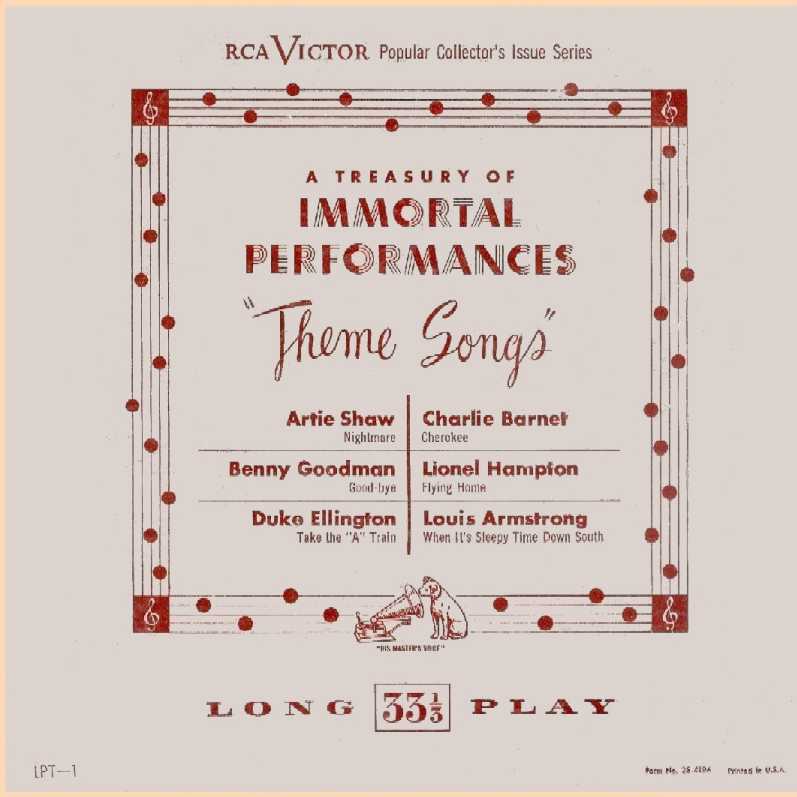
from: 45worlds.com
1951年にRCA Victorが最初に出した33 1/3回転LP(10インチ盤)
「LONG PLAY」とは書かれているが、「LP」とは書かれていない
一方、Columbia が一番最初にリリースした45回転盤は数枚あって、そのうち2枚は “Sometime c/w Stars (Are The Windows Of Heaven) / The Mariners” (Columbia 6-600) と “Goodnight Irene c/w My Blue Heaven / Frank Sinatra” (Columbia 6-718) であることがわかっています。
On the other hand, it is known that among the first 45 rpms released by Columbia are: “Sometime c/w Stars (Are The Windows Of Heaven) / The Mariners” (Columbia 6-600), and “Goodnight Irene c/w My Blue Heaven / Frank Sinatra” (Columbia 6-718).
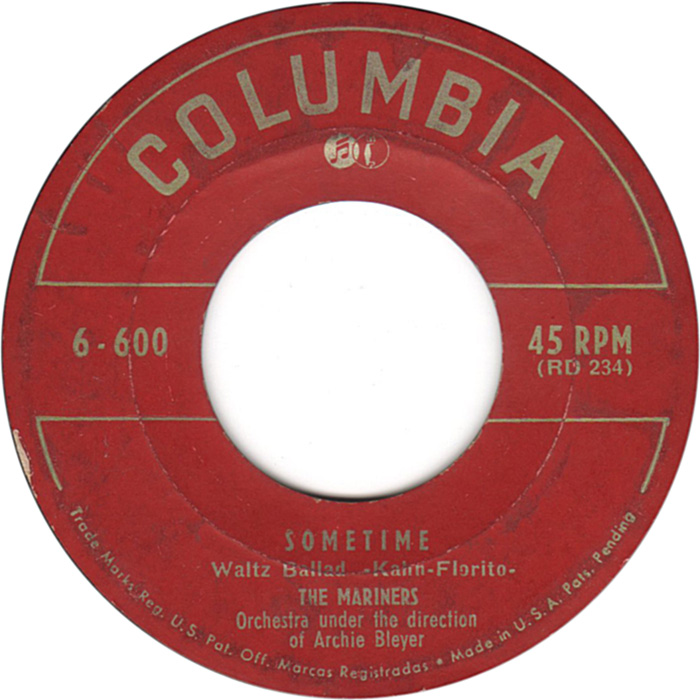
Sometime c/w Stars (Are The Windows Of Heaven) (Columbia 6-600)
source: 45cat.com
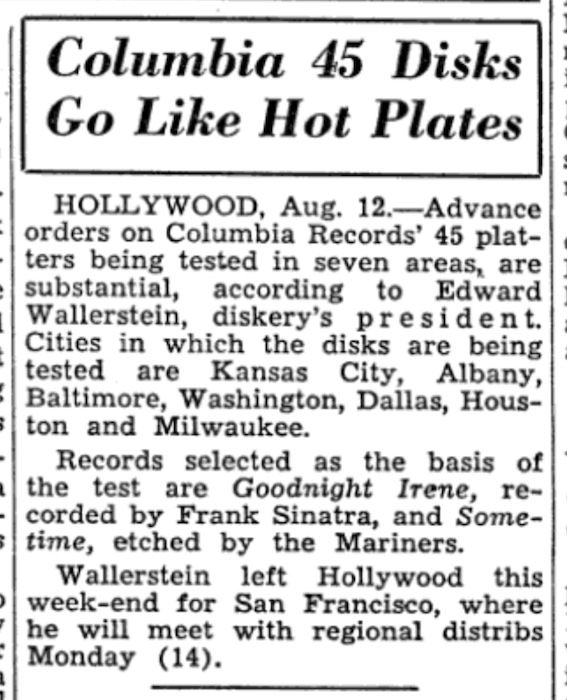
source: “Columbia 45 Disks Go Like Hot Plates”, The Billboard, Vol. 62, No.33, August 19, 1950, p.11
全米7エリアで行われた45回転盤の試験的先行予約の反応は上々、という Wallerstein 氏のコメント
13.1.8 … so what happened to “Columbia’s 7-inch 33 1/3 rpm records”?
で、忘れそうになっていた、Columbia の新メディア、33 1/3回転7インチLPですが、1950年にはまだ売られていました。
Oh, now we nearly forgot about Columbia’s new format, 33 1/3 rpm 7-inch LP — it was still manufactured and sold at least in 1950.
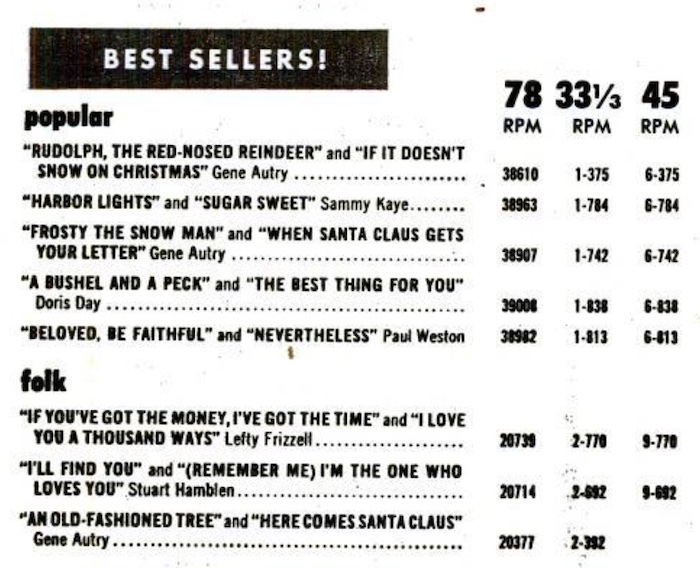
source: “Columbia Records Ad on The Billboard magazine”, The Billboard, Vol. 62, No.46, November 18, 1950, p.21.
1950年11月18日号に掲載された広告より。78回転盤、33 1/3回転7インチ盤、45回転7インチ盤、の3メディアでシングルがリリースされている
しかし、7インチ45回転盤シングルに比べ、7インチ33 1/3回転LPの売れ行きはやはり相当芳しくなかったのでしょう、1951年には数枚がリリースされただけで、結局フェードアウトしてしまいました。
However, 7-inch 33 1/3 rpm LP did not sell well, compared with 7-inch 45 rpm single records. In 1951, only a handful of 7-inch 33 1/3 rpm LP records were released, then the format silently faded out.
時を同じくして、はたまた偶然か、Edward Wallerstein 氏が Columbia 会長職を退くというニュースがかけめぐりました。そして、Columbia からの 45回転盤リリースが本格化していきました。
Almost simultaneously — or coincidentally — the retirement of Columbia’s long-time chairman Edward Wallerstein was announced. Then Columbia accelerated releasing 45 rpms.
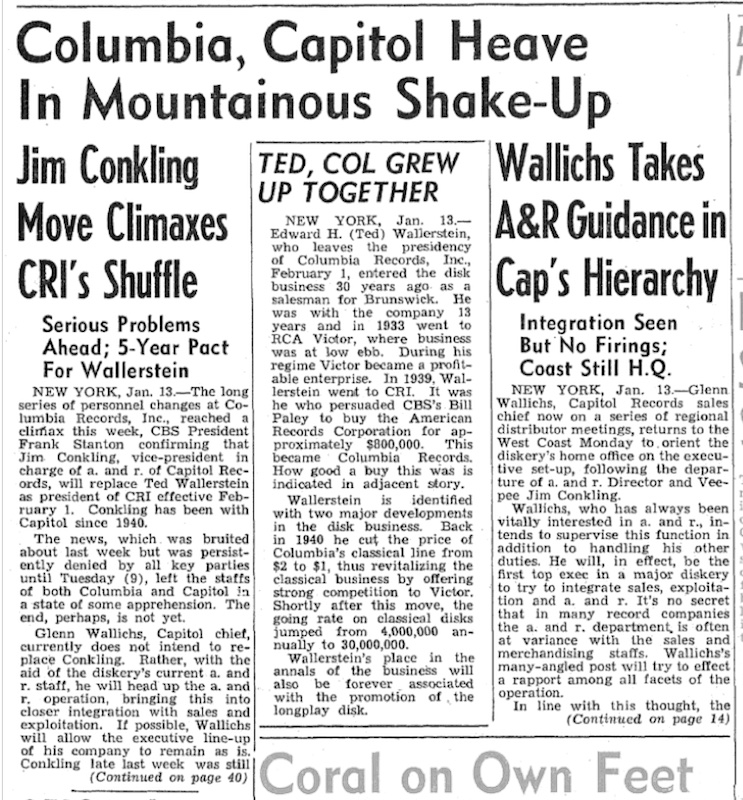
source: “Jim Conkling Move Climaxes CRI’s Shuffle”, The Billboard, Vol. 63, No.3, January 20, 1951, p.10.
Capitol A&R 副代表 Jim Conkling を Columbia 社長に就任させる、と CBS 社長 Frank Stanton が語った、という記事
最後に、Peter Goldmark 氏の自叙伝「Maverick Inventor: My Turbulent Years At CBS」(1973) からの引用です。
The last of this section is a quote from “Maverick Inventor: My Turbulent Years At CBS” (1973), an autobiography of Peter Goldmark.
Before the announcement of the LP, in thinking about a total system we had devised a seven-inch record, a brother to the 33⅓, to play pop tunes. I had them pressed in our plant at Bridgeport to use it in rebuttal to anyone who thought we couldn’t play popular music with the 33⅓ system. At one meeting I had it in my pocket. Only Adrian Murphy knew about it, and he forbade me to pull it out. He thought a short and long record would confuse everybody.
LP発表の前、トータルなシステムとして考える上で、33 1/3回転LPの弟分として、ポップス向けに7インチレコードを考案していた。33 1/3回転はポピュラー音楽には向いていない、と考える人々に反論するべく、ブリッジポートの工場でプレスしてもらっていた。ある会合で、その盤をポケットに忍ばせていた。そのことを知っていたのは Adrian Murphy のみで、その彼がポケットから出すことを禁じた。長時間レコードと短時間レコードがあると、皆を混乱させるだけだ、というのが彼の考えであった。
Later, when RCA came out with the 45 (NOTE: chronologically, this sentence should be “when it was rumored that RCA would come out with the 45”), I showed the record to our management. “Why didn’t you show it to us before?” Stanton demanded. Had we announced it earlier, RCA would have had its tail clipped. There would have been no excuse for the fanfare surrounding the 45, and we would have captured that business as well. We did come out with a seven-incher later, but it bombed because RCA had come on too strong.
のちに、RCAが45回転盤を出した際(訳註: 時系列的に、正確には「45回転を出すという噂が流れ出した時」と思われます)、その(7インチ 33 1/3回転の)レコードをCBSのマネージメントに見せた。(CBS社長の)Stanton は「なぜそれを今まで見せてくれなかったんだ?」と強い口調で言ってきた。(7インチ盤を)もっと早くに発表していたとしたら、RCA は尻尾を巻いていたかもしれないじゃないか、45回転盤のファンファーレは言い訳にもならないし、その(ポピュラー向けシングル盤の)ビジネスも獲得できていたはずだ、と。その後、我々は7インチ(33 1/3回転盤)を出したが、RCA の派手なキャンペーンにより、(我々の7インチ盤は)爆死してしまった。
“Chapter 8: The LP Caper, or the Case of the Missing Fuzz”, “Maverick Inventor: My Turbulent Years at CBS”, Peter C. Goldmark with Lee Edison, Saturday Review Press, 1973, p.14713.2 Technological Background of RCA Victor 45rpm records
ここまでは、当時のメディア(一般紙、業界紙)が45回転盤登場のニュースをどのように扱っていたかをみてきました。
Up to here, we have followed some of the news articles regarding the new 45 rpm system, on general newspapers and industry weekly magazines at the time.
技術目線でこの45回転盤を最初に扱ったのは、ラッカー盤 (audiodisc) やオープンテープ (audiotape) を製造販売していた Audio Devices 社が出版していた Audio Record 誌でした。
The Audio Record magazine, published by Audio Devices, Inc. (maker of lacquer discs “audiodisc” and reel-to-reel tapes “audiotape”) was one of the earliest, reporting the new 45 rpm system from technical point of view.
13.2.1 Audio Record, February 1949: “Report on Madame X, RCA Victor’s New 45 RPM Record”
まず1949年2月号にて、新登場の45回転盤、コードネーム「Madame X」について、当時分かっている情報が解説されています。
Feb. 1949 issue of the Audio Record magazine reports what has been known (so far) about the new RCA Victor 45 rpm record, code-named “Madame X”.
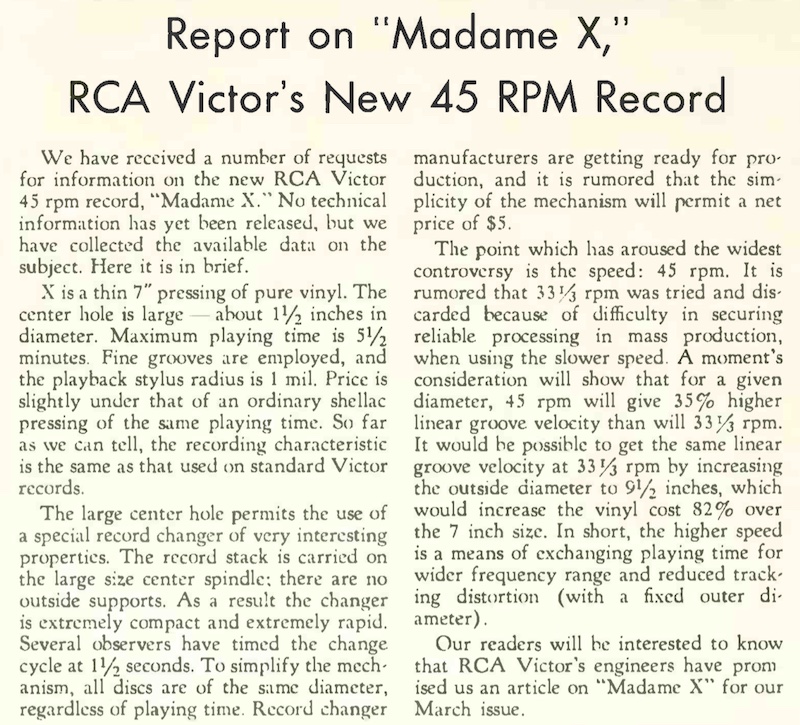
source: Audio Record, Vol.5, No.2, February 1949, p.4
We have received a number of requests for information on the new RCA Victor 45 rpm record, “Madame X”. No technical information has yet been released. but we have collected the available data on the subject. Here it is in brief.
RCA Victor の新型45回転盤「Madame X」の情報が欲しい、という要望が多く寄せられている。技術情報はまだ公開されていないが、現時点で判明しているデータを集めてみた。以下、その概要である。
X is a thin 7” pressing of pure vinyl. The center hole is large — about 1 1/2 inches in diameter. Maximum playing time is 5 1/2 minutes. Fine grooves are employed, and the playback stylus radius is 1 mil. Price is slightly under that of an ordinary shellac pressing of the same playing time. So far as we can tell, the recording characteristic is the same as that used on standard Victor records.
コードネーム Madame X は、7インチのヴァイナル盤である。センターホールは 1.5インチと大きなサイズである。最大収録可能時間は(片面)5分半である。微細な溝で記録されており、再生用針の曲率半径は1ミルである。価格は同時間収録の通常のシェラック盤より若干下回る。この新メディアで使われている録音特性は、現時点で言えるのは、通常の Victor 盤(シェラック盤)と同じものである。
Report on “Madame X”, RCA Victor's New 45 RPM Record, Audio Record, Vol.5, No.2, February 1949, p.4.この時点ですでに、録音EQカーブについての言及があるのが、さすがにプロフェッショナル向けメーカの出版記事だけのことはあります。「通常の Victor 盤と同じ」とされる録音特性については、のちほど RCA Victor の技術論文でみていきます。
This article, authored by someone who worked at such professional manufacturer as Audio Devices does mention the recording characteristic for the 45 rpm, which is simply impressive. The recording characteristic which is “the same as that used on standard Victor records” will be covered in the following section of RCA Victor’s technical paper.
The large center hole permits the use of a special record changer of very interesting properties. The record stack is carried on the large size center spindle; there are no outside supports. As a result the changer is extremely compact and extremely rapid. Several observers have timed the change cycle at 1 1/2 seconds. To simplify the mechanism, all discs are of the same diameter, regardless of playing time. Record changer manufacturers are getting ready for production, and it is rumored that the simplicity of the mechanism will permit a net price of $5.
この大きなセンターホールにより、非常に興味深い機能を持つ特製レコードチェンジャーの使用が可能となる。スタックされた盤は、外側からサポートされるのではなく、大型のセンタースピンドル側で保持される仕組みとなっている。その結果、このオートチェンジャー機は非常にコンパクトであり、かつ非常に高速に動作する。また、機構をシンプルにするべく、再生時間に関係なく、全てのディスクの直径は同じである。レコードチェンジャーのメーカはすでに製造準備を進めており、シンプルな機構とあいまって、正味5ドルの価格での販売が可能、と噂されている。
The point which has aroused the widest controversy is the speed: 45 rpm. It is rumored that 33 1/3 rpm was tried and discarded because of difficulty in securing reliable processing in mass production, when using the slower speed. A moment’s consideration will show that for a given diameter, 45 rpm will give 35% higher linear groove velocity than will 33 1/3 rpm. It would be possible to get the same linear groove velocity at 33 1/3 rpm by increasing the outside diameter to 9 1/2 inches, which would increase the vinyl cost 82% over the 7 inch size. In short, the higher speed is a means of exchanging playing time for wider frequency range and reduced tracking distortion (with a fixed outer diameter).
最も大きな論議を呼んだのは、45rpm という回転数である。噂によると、33 1/3rpm という遅い回転数も試されたが、大量生産で確実な生産ができないため、試行錯誤の末に 33 1/3回転が却下されたとのこと。すこし考えればわかることであるが、33 1/3回転に比べて45回転の方が線速度が向上する。ディスク外径を9.5インチにすれば、33 1/3回転で(45回転と)同じ線速度を得ることが可能だが、これはすなわち7インチ盤に比べてレコードのコストを82%もあげることになる。つまり、回転速度をあげたのは、ディスク外径を固定したまま、再生時間を引き換えにして、より広い周波数帯域とトラッキング歪の低減を実現するため、ということである。
Our readers will be interested to know that RCA Victor’s engineers have promised us an article on “Madame X” for our March issue.
本誌の読者諸兄が興味を持つであろうお知らせがある。RCA Victor 社のエンジニアが、本誌来月号に掲載する「Madame X」に関する記事の執筆を約束してくれたのだ。
Report on “Madame X”, RCA Victor's New 45 RPM Record, Audio Record, Vol.5, No.2, February 1949, p.4.RCA Victor のアイデアは、原材料費を圧縮するために盤のサイズを小さく、センターホールを大きく、盤を薄くし、長時間再生をあきらめ、回転数をあげることで、周波数帯域や録音再生品質を確保した、というものでした。12インチ78回転盤と同じ収録時間を 6 7/8 インチで確保可能、かつ1枚あたりに要する原材料を少なくできる、と。
So RCA Victor had an idea: smaller disc size, less thickness, larger center hole, all for reducing raw material costs; giving up long playing feature, slower rpm than shellac records but faster rpm than Columbia LP, all for obtaining wider frequency range and better fidelity. A 6 7/8-inch 45 rpm disc can hold the music of the same playing time as on the 12-inch 78 rpm disc, while reducing the material cost much.
一方、Columbia 社が10インチおよび12インチのLPを実用化できたのは、シェラックよりもヴァイナルの方が原材料費が高くなるが、多くの楽曲が収録可能になるから、1曲あたりの原材料コストを圧縮できる、というアイデアのおかげでした。市販の78回転盤にヴァイナル盤が少なかった最大の理由は、この1曲あたりの原材料費が高くなるからでした。
On the other hand, Columbia had another idea: vinyl compound costs more than shellac compound, but the cost “per track” can be reduced because 45 minutes of music (8 to 12 tracks) on both sides. The high cost of vinyl compound also explains the reason why vinyl 78 rpm records were not popular.
13.2.2 Audio Record, March 1949: “The How and Why of RCA Victor’s New Record and Player”
そして、約束通り、Audio Record 誌の翌月号に、RCA Victor 家電部門のチーフエンジニア、 D.D. Cole 氏による解説記事が掲載されました。3ページ強にもわたる力作で、末尾には充実のQ&A集まで収録されています。
As promised, D.D. Cole, chief engineer of RCA Victor’s Home Instrument Department, wrote a interpretive article on the Mar. 1949 issue of Audio Record. This three-page article also includes Q&As at the end.
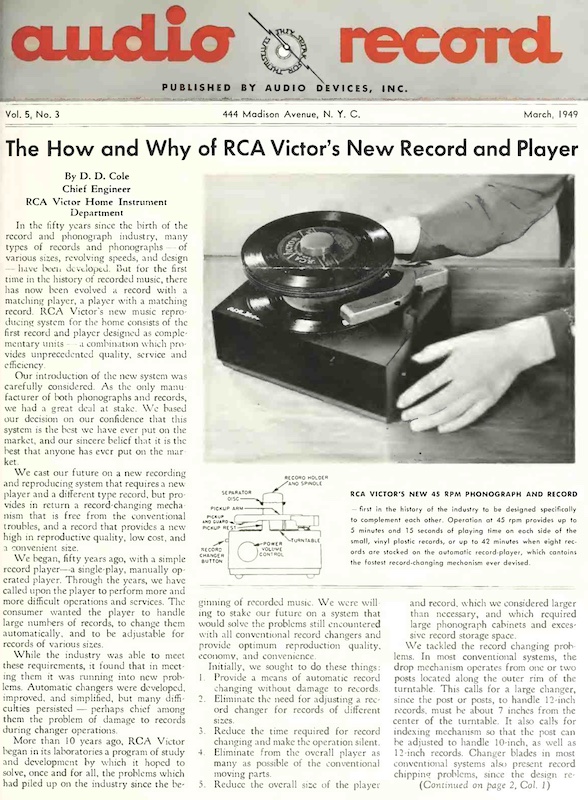
source: Audio Record, Vol.5, No.3, February 1949, pp.1-4.
技術論文ではないので数式などは使われておらず、45回転盤開発の動機や目的、特徴などについて平易に解説されており、読みやすいです。ぜひ 読んでみてください。
No equation is in the article, as this article is not a technical paper. It simply describes the motivation, purpose and characteristics of the new 45 rpm system, in plain words. It’s very easy to read.
ざっくり要約すると、こんな感じでしょうか。
- コンパクトなオートチェンジャーシステムを開発したい
- 従来のオートチェンジャーや従来の78回転盤では実現が難しい
- そこで、まったく新しいレコード盤とオートチェンジャーを開発した
- 盤を外側から保持するのではなく内側から保持すれば全体をコンパクトに作れる
- スピンドル側から盤を保持しターンテーブルに落としやすいように 1.5インチの大型スピンドルにした
- 記録面よりレーベル面を盛り上がらせているのは、オートチェンジャーでスタックした際に記録面が傷つかないようにするため
- オートチェンジャーをシンプルにするために、レコード盤のサイズは1種類とした
- 12インチ78回転盤と同じ収録時間(5分20秒)を確保しつつ、内周歪が発生しにくい「クオリティゾーン」に記録するために、6 7/8 インチというサイズ、かつ45回転となった
The rough summary of the story would be something like this:
- Desire to develop a compact record changer system
- impossible with regular 78 rpms and regular record changer system
- So developed the brand new records and auto-changer system
- can reduce the dimension of the player, by eliminating outside record posts
- 1 1/2 inch center spindle was developed to hold and drop the record from inside the spindle
- raised area of the center label was for keeping the space between stacked records
- one-size record was intended to simplify the record changer mechanism
- the size of 6 7/8 was determined in order to keep the same playing time of 12-inch 78 rpms (five and one-third minutes), while keeping to use the “quality zone” of the record surface (to avoid distortion in the inner diameter)
そして、この解説記事中では、再生針は「曲率半径0.001インチのサファイア針」と明記されています。誰だ、最初に0.0009インチとリークした人は!(笑)
And this article also mentions the reproducing stylus “has a .001-inch tip radius” and is “Silent Sapphire permanent-point pickup”. So who initially leaked the misleading information of “.0009-inch tip radius”? 😉
Q&A の最後には、こんな記述もあります。1939年、ということは、Columbia の長時間レコード開発開始とほぼ同じということになりますね。
The last item from the “Questions and Answers” corner is shown below — 1939 is the same year when Columbia began its LP development.
Q. How long did it take RCA Victor to develop this new system?
Q. RCA Victor がこの新システムの開発にどれくらいの期間を費やしましたか?
A. Research and experimentation began in 1939. By 1942 the first model was perfected. Then followed years of testing and refinement from which finally emerged the RCA Victor record playing system.
A. 研究開発は1939年に開始されました。1942年には最初のモデルが完成しました。その後数年をかけてテストと改良が進められたのち、RCA Victor レコード再生システムとして世に出されました。
Questions and Answers on the New RCA Victor Record Playing System, Audio Record, Vol.5, No.3, March 1949, p.4.Columbia の LP 開発ストーリーがふんだんに残っているのと異なり、RCA Victor 45回転盤の開発史はほとんど明らかになっていません。ですが、Columbia LP がお披露目されてからたった半年強で正式公開できたことから、かなり昔から研究開発が行われてきた(そしてリリースされずに温存していた)技術が使われたのは間違いないでしょう。
The story of the development of RCA Victor’s 45 rpm disc is (unfortunately) not clear, while Columbia’s LP story is well interviewed and archived. Anyway, RCA Victor actually released the new system just six months after the Columbia LP release, so the new system surely derived from the result of RCA Victor’s past research and experimentation (and preserved).
13.2.3 “A Record Changer and Record of Complementary Design” (June 1949)
RCA の研究部門が発行していたテクニカルジャーナル RCA Review の1949年6月号に、この新型45回転盤システムについての技術論文が掲載されています。
June 1949 issue of the RCA Review, technical journal published by RCA Laboratories Division, features a technical paper on the new 45 rpm record system.
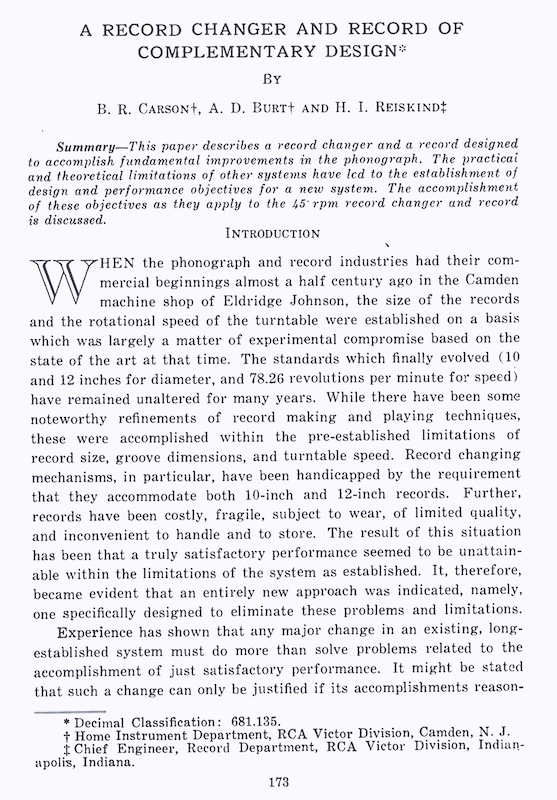
source: “RCA Review, Vol.X, No.2, June 1949”, pp.173-190
3人による執筆で、B.R. Carson 氏と A.D. Burt 氏は家電部門のエンジニア、そして H.I. Reiskind 氏は RCA Victor レコード部門のチーフエンジニアです。
The authors of this paper are: B.R. Carson and A.D. Burt (engineers, Home Instrument Department), as well as H.I. Reiskind (chief engineer, RCA Victor Record Division).
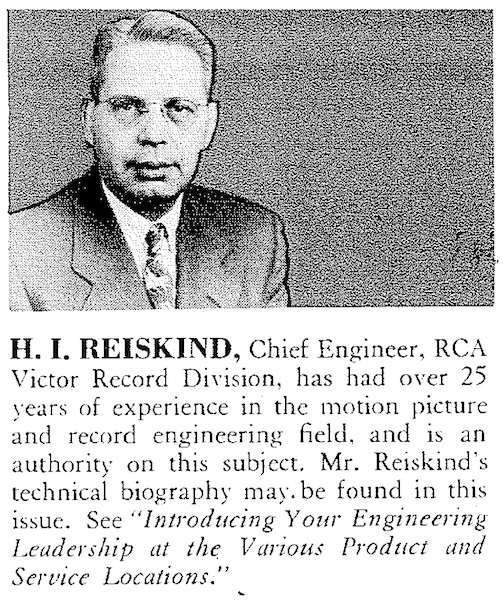
H.I. Reiskind, Chief Engineer, RCA Victor Record Division
source: RCA Engineer, Vol. 1, No. 1, June-July, 1955, p.48
Reiskind 氏の名前は、本稿 Pt.9 セクション 9.2.5 にも出てきたほか、1949年NAB録音再生標準規格策定ストーリーを扱った Pt.10 にも、NAB標準規格執行委員会メンバとして登場しています。
The name of Mr. Reiskind already appeared in my past articles: in Pt. 9 Section 9.2.5; also in Pt.10, as a member of the NAB Recording and Reproducing Standards Committee.
この技術論文の肝となるのは、オートチェンジャー機構の解説、および、「45回転」という速度が採用されるに至った経緯を数式を使って解説、の2つです。特に後者では、実現したい再生可能時間、回転数、盤の最外周と最内周におけるサイズ、線速度、単位あたりの溝数、などによる数式で説明され、同時に Lewis & Hunt の例の論文を引用しつつ、トレーシング歪を数学的に論じています。
The heart of this technical paper is: description of record changer mechanism; and why RCA finally adopted the speed of 45 rpm, using equations. Especially the latter uses maximum possible playing time, disc diameter, start and end of recording in inches diameter, linear velocity, grooves per inch, etc.; also the mathematical discussion on tracing distortion was made by quoting that Lewis & Hunt’s legendary paper.
本論文冒頭では、過去の歴史と新型オートチェンジャー開発に至る経緯が語られています。
The Introduction part of this paper describe the past history of phonograph, as well as RCA’s desire to develop a wholly new record changing system.
WHEN the phonograph and record industries had their commercial beginnings almost a half century ago in the Camden machine shop of Eldridge Johnson, the size of the records and the rotational speed of the turntable were established on a basis which was largely a matter of experimental compromise based on the state of the art at that time. The standards which finally evolved (10 and 12 inches for diameter, and 78.26 revolutions per minute for speed) have remained unaltered for many years. While there have been some noteworthy refinements of record making and playing techniques, these were accomplished within the pre-established limitations of record size, groove dimensions, and turntable speed. Record changing mechanisms, in particular, have been handicapped by the requirement that they accommodate both 10-inch and 12-inch records. Further, records have been costly, fragile, subject to wear, of limited quality, and inconvenient to handle and to store. The result of this situation has been that a truly satisfactory performance seemed to be unattainable within the limitations of the system as established. It, therefore, became evident that an entirely new approach was indicated, namely, one specifically designed to eliminate these problems and limitations.
いまから半世紀前、ニュージャージー州カムデンの Eldridge Johnson の機械工場で蓄音機とレコード産業が始まった際、レコード盤のサイズとターンテーブルの回転速度は、当時の技術水準に基づく実験的な妥協の産物といえるものであった。盤のサイズは10インチと12インチ、回転数は毎分78.26回転、という規格は、長い間変わることなく受け継がれてきた。レコード製造や再生における注目すべき改良もあったが、レコードのサイズ、記録溝のサイズ、ターンテーブル回転数など、あくまで決められた制限の中で行われた。特にオートチェンジャーは、10インチと12インチの両方に対応しなければならない、という大きなハンディキャップがあった。さらに、レコードは高価で、割れやすく、摩耗しやすく、品質が良いとは言えず、取り扱いや保管は不便であった。このような状況から、従来のシステムの制約の中では、真に満足できる性能を得るのは不可能であると考えた。そこで、このような問題や制約を解消するべく、全く新しいアプローチが必要であることが明らかとなった。
Experience has shown that any major change in an existing, long-established system must do more than solve problems related to the accomplishment of just satisfactory performance. It might be stated that such a change can only be justified if its accomplishments reasonably approach the requirements of an ideal system. About seventeen years ago there began a program aimed at a fundamental improvement in the reproduction of recorded music. Unhampered by any previous restrictions, attempt was made to develop an ideal method of bringing recorded music into the home. Factors of cost and convenience to the customer, playing time, record life, freedom from distortion and numerous technical considerations were established with the “ideal” being the objective. Some nine years of research and experimentation culminated in a new record playing means which, after eight more years of testing and refinement, finally emerged in a record changer and record to be discussed in this paper.
長期間に渡り定着していた既存のシステムに大きな変更を加える場合、単に満足のいく性能を達成し、問題を解決するだけでは不十分であることは、経験上明らかである。言い換えると、このような変更は、その成果が理想的なシステムの要件に合理的に近づく場合にのみ正当化されるのだ。今をさかのぼること17年前、録音された音楽の再生の根本的な改善を目的としたプログラムが開始された。それまでの制約に囚われることなく、録音された音楽を家庭に届ける理想的な方法を開発しようとしたのである。顧客にとってのコスト、利便性、再生時間、レコードの寿命、歪からの解放、など、さまざまな技術的な要素を考慮した上で、目標とする「理想」を設定した。9年間にわたる研究と実験の結果、レコード再生の新方法が生まれ、さらに8年間の試験と改良を経て、この論文で取り上げるレコードチェンジャーとレコードが誕生したのである。
A Record Changer and Record of Complementary Design, RCA Review, Vol.X, No.2, June 1949, pp.173-190.この論文が書かれたのは1948年〜1949年でしょうから、その17年前ということは、1931年〜1932年です。つまり、Pt. 4 セクション 4.2 や Pt. 11 セクション 11.2.1 で紹介した、RCA Victor Program Transcription 開発あたりがそのスタートということになります。話を多少盛っている可能性はありますが(笑)、Pt. 11 セクション 11.2.2 でみたように、Wallerstein 氏へのインタビュー中、「エンジニアの Fred Barton 氏が、 1mil のレコードをカッティングしてもいいか、と言ってきたことがある」という箇所と呼応します。
This paper was authored in 1948 or 1949, so “About seventeen years ago” stands for 1931 or 1932. So “a program aimed at a fundamental improvement in the reproduction of recorded music” started as a development of RCA Victor’s Program Transcription records, as we already have seen in Pt. 4 Section 4,2 and Pt. 11 Section 11.2.1. Although the story might be exaggerated a bit, we already read the interview with Edward Wallerstein (see: Pt. 11 Section 11.2.2) which says: “When I was at RCA, engineer Fred Barton asked me if he could cut some 1-mil records. That was in 1935 or ’36.”.
本論文上において興味深い箇所は、5分20秒という再生時間で十分である、と説明する箇所です。いわく、RCA Victor が長らく発行している「The Music America Loves Best」(アメリカのベストセラー音楽)という書籍に収録された全楽曲の演奏時間を調べ、クラシック(Red Seal レーベル)であっても、70% 以上の楽曲が 5分20秒以内であり、Victor が売り上げている全レコード中では、96% の楽曲が5分20秒以内である。つまり、全米でレコード販売されている音楽の大半は、45回転盤で十分にカバーできる、という、著者たちの(正確には「RCA Victor 社としての公式見解という)理屈です。
One of the most important paragraphs in this paper is the line describing “five and one-third minutes of playing time is enough”: playing times of all tunes on the book “The Music America Loves Best” published by RCA Victor, and even on the Classical tunes (on Red Seal label), over 70 percent among the entire catalog plays within five minutes and twenty seconds; also, 96 percent of all Victor records (for sales volume) plays within five minutes and twenty seconds; so the vast majority of recorded music can be covered with the new 45 rpm record system, according to the authors (or RCA Victor’s official position).
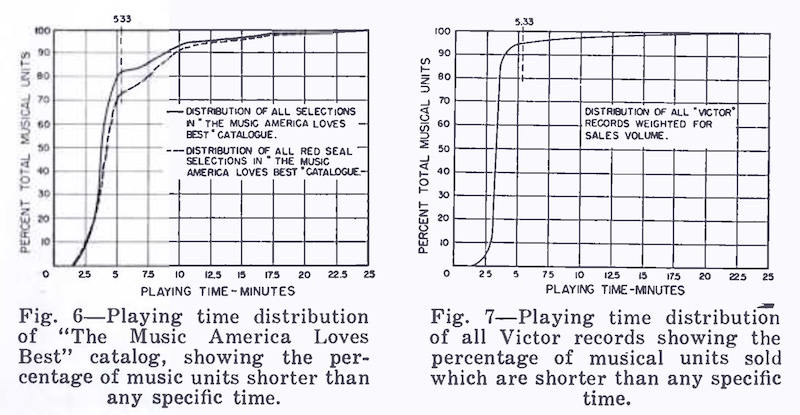
source: “RCA Review, Vol.X, No.2, June 1949”, pp.173-190.
“The Music America Loves Best” 掲載中7割の楽曲が5分20秒以内、Victor がリリースするレコード中売り上げの96%が5分20秒以内の楽曲、と示すグラフ
そして、今回もお待たせしました(笑)。RCA Victor 45回転盤における録音EQカーブ を解説するパートです。
Then, finally — thank you so much again for waiting — the paper briefly describes the recording characteristic for RCA Victor 45 rpm records, only using the plotted graph (similar as the Columbia LP record paper we already have seen in the Pt. 12 Section 12.2.3).
RECORDING AND REPRODUCING CHARACTERISTICS
録音再生特性
The recording characteristic used for these records is shown in Figure 11. For use in calibrating reproducing systems, a frequency record has been prepared. Calibrations by both the variable speed turntable and the light pattern methods were found to be in good agreement. The calibration of the record is shown in Figure 12.
これらのレコードで使用される録音特性を図11に示す。再生装置の計測・較正(校正)用に、周波数レコードを用意した。可変速ターンテーブル計測とライトパターン計測の両方が、良好に一致することが確認された。このレコードによる較正を図12に示す。
A Record Changer and Record of Complementary Design, RCA Review, Vol.X, No.2, June 1949, pp.173-190.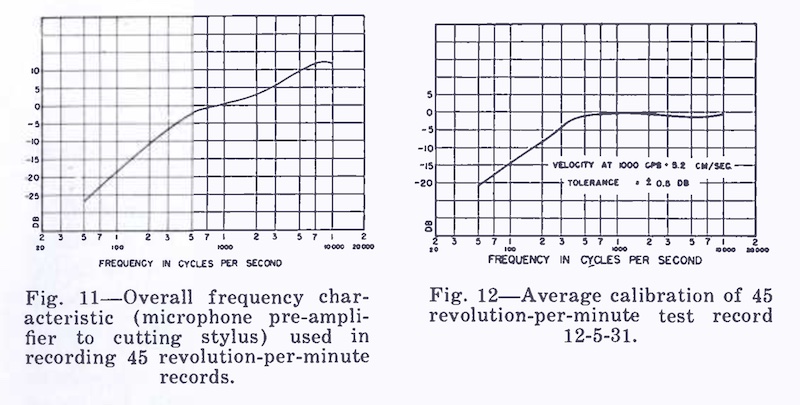
source: “RCA Review, Vol.X, No.2, June 1949”, pp.173-190.
RCA Victor 45回転盤で採用された録音特性(左)、および45回転テストレコード 12-5-31 の記録特性(右)
今回もまた、プロットされたグラフのみの提示ですが、よくみてみると、その特徴がわかります。
It is, again, shown in the form of plotted graph only, but the close inspection shows its characteristic.
のちの New Orthophonic カーブ(すなわち 1953 NARTB = 1954 AES = 1954 RIAA カーブ)に近いですが、それらのカーブに存在する、そして 1942年 Orthacoustic カーブ(放送局トランスクリプション盤用)すなわち NAB カーブや、Columbia LP カーブにも存在する、低域におけるブーストがありません。続いて、高域プリエンファシス部分ですが、7,000Hz〜8,000Hz あたりより上はローパスフィルタで減衰させられているかのようにみえます。そしてカーブは 10,000Hz までしか描かれていません。
The recording characteristic resembles RCA Victor’s future “New Orthophonic” curve (thus 1953 NARTB = 1954 AES = 1954 RIAA curves), but lacks low-bass pre-emphasis that Orthacoustic / NAB / Columbia LP curves have. Also, in the high-frequency area, somewhere above 7,000~8,000 Hz looks as if it is attenuated by a low-pass filter. Also, the curve was only plotted up to 10,000Hz.
この「ローパスフィルタで減衰させられているように見える高域部分」は、単純に、1949年当時まだ Columbia 社内でのみ使われていた極秘技術「Heated Stylus」が使われていなかったことよる、記録性能限界によるものかもしれません。(Pt.12 セクション 12.2.1 参照)
This region of “high-frequency area looking as if it is attenuated by a low-pass filter” could simply be the result of the cutterheads without “Heated Stylus” technique, which was kept secret inside Columbia at the time of the year 1949. (see also: Pt.12 Section 12.2.1)
ともあれ、これが、1940年代中頃(R.C. Moyer氏によると1948年)から1952年まで使われていた、通称「Old Orthophonic」カーブということになります。
So, anyway, this is so-called “Old Orthophonic” curve, which RCA Victor used from mid-1940s (1948, according to R.C. Moyer) to 1952.
前回 Pt. 12 セクション 12.1.4、セクション 12.2.1 および セクション 12.2.2 で説明した通り、1949年当時は、ホットスタイラス技術は Columbia のみが秘密裏に使っていた技術でした。高域減衰をせずに静粛なカッティングする技術はまだ Columbia 以外は(放送局用技術としても)持っていませんでした。これが、カーブのグラフが 10,000Hz までしかプロットされていない最大の理由ということになります。もちろん、10,000Hz までのグラフ、というのは、1939年 Orthacoustic も、1942年 NAB も、1949年 NAB も、1949年 Columbia LP も、全て同じです。
As I mentioned in the previous Pt.2, Section 12.1.4, Section 12.2.1, and セクション 12.2.2, Columbia exclusively (and secretly) used “Hot Stylus” recording technique in the year 1949. All recording studios except Columbia did not have a technology that enabled quiet cutting as well as wider frequency cutting. This surely is why the highest frequency plotted on all the graphs that we have seen in my past parts is 10,000Hz — 1939 Orthacoustic, 1942 NAB, 1949 NAB, 1949 Columbia LP — all plotted up to 10,000Hz.
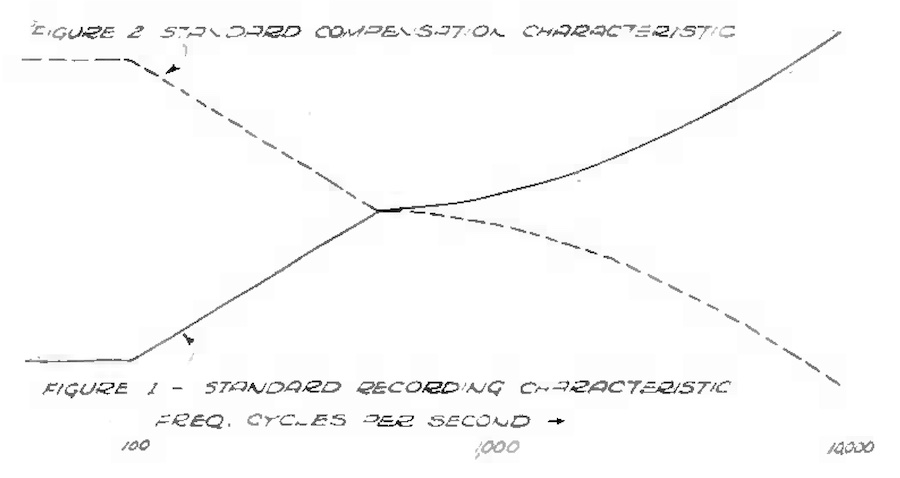
source: “RCA-NBC Orthacoustic Recording”, Robert M. Morris, ATE Journal, December 1939, pp.15-16
ATE Journal 1939年12月号に掲載された Orthacoustic 録音再生カーブ
Figure 1 (実線) が録音カーブ、Figure 2 (破線) が再生カーブ
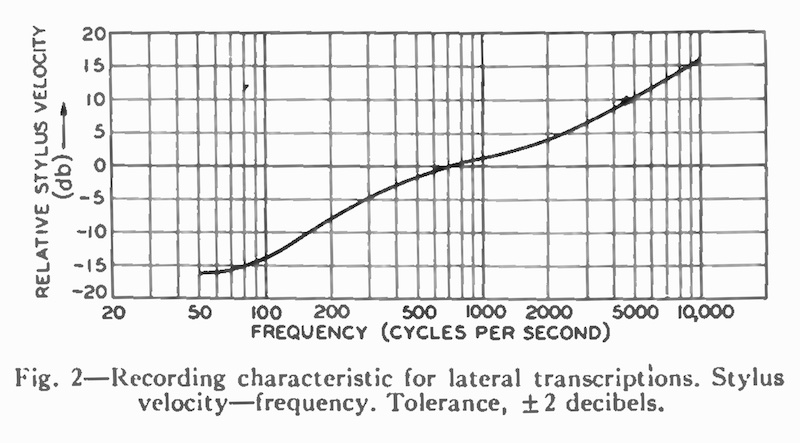
source: “Recording and Reproducing Standards”, Proceedings of the I.R.E., August 1942, Vol.30, No.8, pp.355-356
1942年NAB録音・再生標準規格の第13項目として定義された、横振動用録音周波数特性グラフ
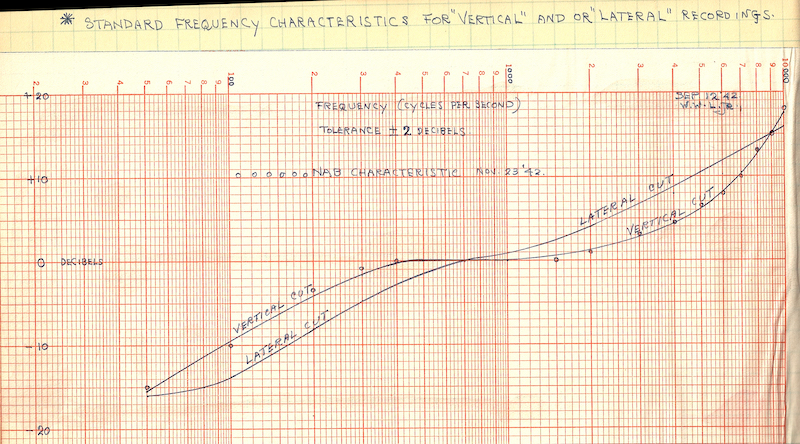
Western Electric Vertical/Lateral Recording Characteristics (1942 NAB), drawn on Nov. 23, 1942
Western Electric 社の縦振動/横振動用録音カーブ (1942 NAB vertical/lateral) をプロットした貴重なグラフ (Nicholas Bergh さん提供)
photo courtesy of Nicholas Bergh.
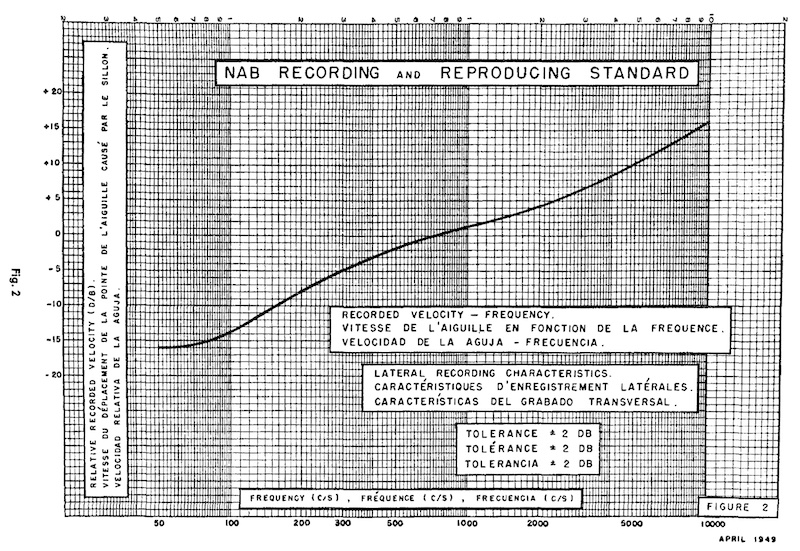
source: “The Recording and Reproduction of Sound”, Oliver Read, 2nd Edition, 1952, p.690
1949年NAB標準規格に掲載された、横振動トランスクリプション盤用録音カーブのグラフ
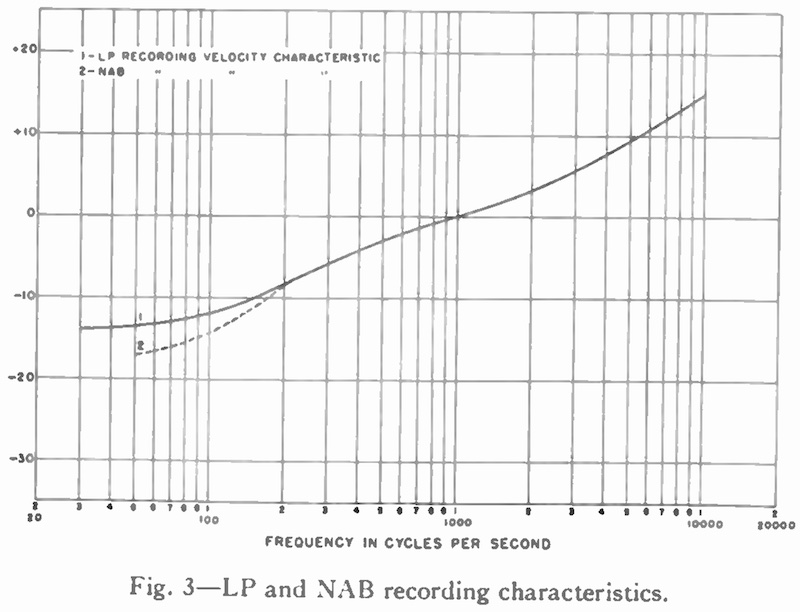
source: Proceedings of the I.R.E., August 1949, Vol.37, No.8, pp.926.
Columbia LP 録音カーブと、1949 NAB 録音カーブ
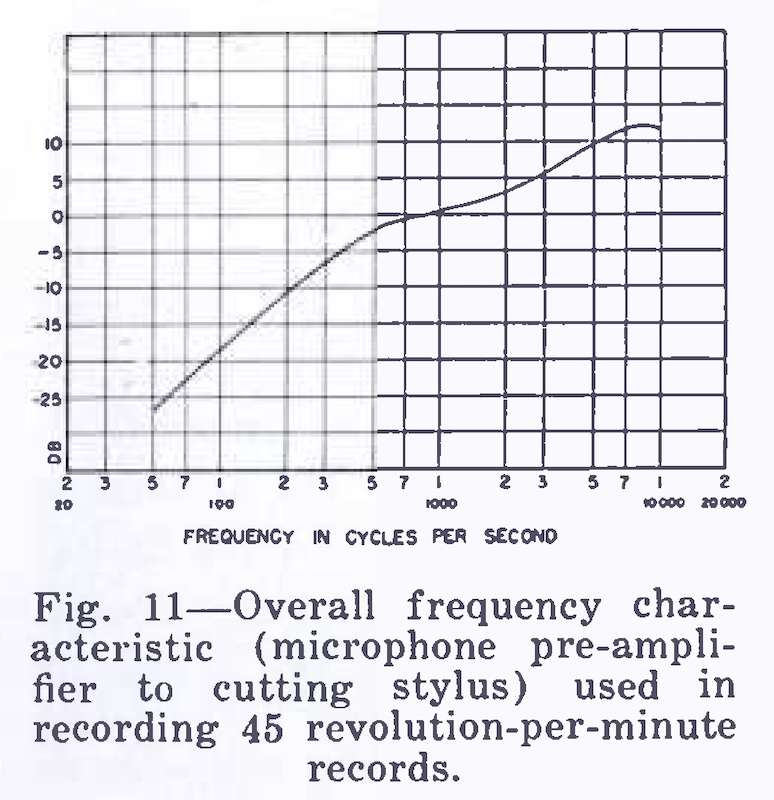
source: “RCA Review, Vol.X, No.2, June 1949”, pp.173-190.
RCA Victor 45回転盤で採用された録音特性、通称「Old Orthophonic」カーブ
そして、そのホットスタイラス技術が Bachman 氏の技術論文で1950年に公開され、カッターヘッド製造メーカ各社や各スタジオで使われるようになり、記録可能な周波数帯域が上に伸びたことで、1952年に RCA Victor は高域のローパスフィルタを撤廃した、さらに低域ブーストを追加した、それが New Orthophonic カーブ(つまり 1953 NARTB = 1954 AES = 1954 RIAA カーブ)となった、ということですね。
Then the “Hot Stylus” technique was officially disclosed on William S. Bachman’s technical paper in 1950; many equipment manufacturers and studios followed, maximum possible frequency range went higher. Then in 1952, RCA Victor discarded high-frequency low-pass filter in 1952, and added low-bass boost, which became the New Orthophonic curve (then 1953 NARTB = 1954 AES = 1954 RIAA).
また、記録可能な周波数帯域が上に伸びたことで、Orthacoustic = NAB ≒ Columbia LP のような高域プリエンファシスでは、10,000Hz〜15,000Hz の増幅が強すぎて歪がますます大量発生することになる、これがまさに、1949年NAB録音再生標準規格策定の歴史を追った Pt.10 で何度も議論されていた「高域プリエンファシスを弱めるべきだ」という議論の延長線上にあるのです。
Also, because the highest possible frequency was extended higher, it was found that such traditional high-frequency pre-emphasis as in Orthacoustic = NAB ≒ Columbia LP would result in excessive pre-emphasis in the 10,000~15,000Hz region, thus excessive high frequency distortion. This fact is on an extention of the discussion during the formulation of 1949 NAB Recording and Reproducing Standards, as seen in Pt.10.
13.2.4 RCA Victor Record Changers
最後に、当時 RCA Victor が一般市場向けに製造販売していた45回転盤用ターンテーブルをみていきましょう。
Lastly, let’s take a look at 45 rpm turntables that RCA Victor initially introduced in 1949.
世界初の45回転盤用プレーヤ(オートチェンジャー機)は 9JY というモデルでした。以下の YouTube 動画で紹介されているのがそれで、このオートチェンジャーの動きは、今みてもかなりグッときますね。
The world’s first 45 rpm record player (record changer attachment) was Model 9JY. THe following YouTube video demonstrates the 9JY in action, that really attracts me (or us)!
13.3.1 RCA Victor Service Data (1949, 1950)
当時の RCA Victor Service Data という、保守用マニュアル群によると、圧電型(クリスタルまたはセラミック)ピックアップが標準装備されていたようです。そのため、再生用補正回路は一切存在せず、基本的にクリスタルピックアップの出力をそのまま RCA OUT から出していることがみてとれます。以下、1949年版の RCA Victor Service Data からです。
According to the maintenance documentation named RCA Victor Service Data Almost all of the turntables had piezo-electric (crystal or ceramic) pickups installed. So the output from the piezo-electric pickup was directly to the RCA OUT connector, without using pre-amplifier or phono EQ compensentator. Following is from the 1949 edition of RCA Victor Service Data.
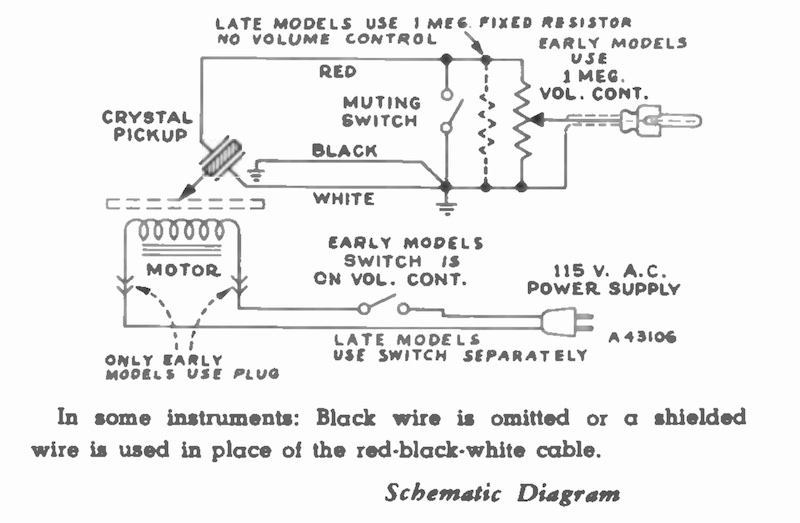
source: Record Changer Attachment, Model 9JY (Mfr. No. 274) Service Data (1949 No. 2), RCA Victor Service Data, Volume V, 1949.
また、この 9JY(RCA OUT のみの純粋なプレーヤ)に限らず、当時 RCA が製造販売していた 9EY3 / 9EY31 / 9EY32 / 9EY35 / 9EY36 (アンプとスピーカ内蔵プレーヤ)、9Y7 / 9Y51 / 9W51 / 9W102(45回転オートチェンジャー付きラジオ/スピーカ一体型オーディオ)、9W78 / 9W101 / 9W103 / 9W105 / 9W106(45回転オートチェンジャーと78回転ターンテーブル付きラジオ/スピーカ一体型オーディオ)、9TW309 / 9TW333 / 9TW390(45回転オートチェンジャーと78回転ターンテーブル付きテレビ/ラジオ/スピーカ一体型オーディオ)、などなど、数多くのオーディオ機器で共通採用されていたのが、45回転オートチェンジャーターンテーブル RP-168 シリーズでした。
The turntable unit called RP-168 Series was used for various RCA audio system, not only the 9JY (automatic 45rpm record player attachment only, with RCA OUT), but also 9EY3 / 9EY31 / 9EY32 / 9EY35 / 9EY36 (automatic 45rpm record players, with built-in speaker and amplifier); 9Y7 / 9Y51 / 9W51 / 9W102 (automatic 45rpm record players and AM/FM radio combination unit with built-in speaker and amplifier); 9W78 / 9W101 / 9W103 / 9W105 / 9W106 (automatic 45rpm record player and 78rpm record player and AM/FM radio combination unit with built-in speaker and amplifier); 9TW309 / 9TW333 / 9TW390 (automatic 45rpm record player and 78rpm record player and TV and AM/FM radio combination unit with built-in speaker and amplifier), etc.
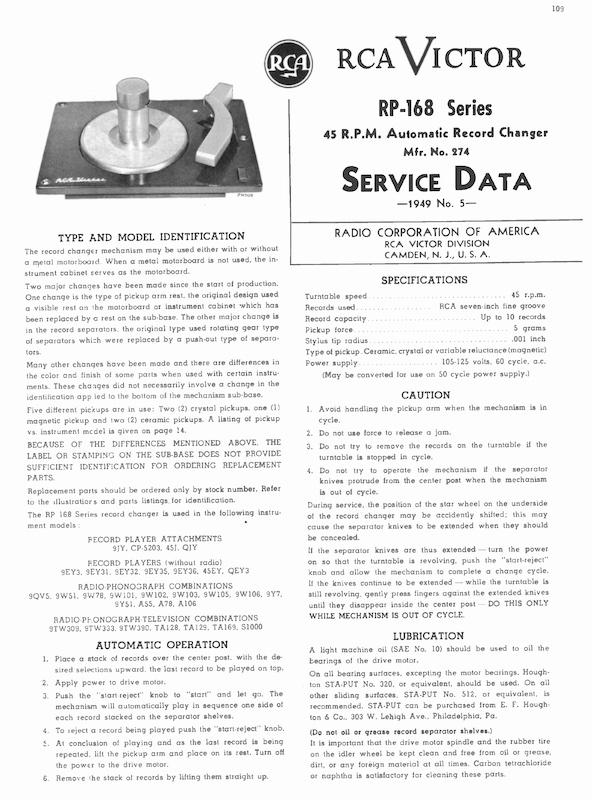
source: RP-168 Series 45 R.P.M. Automatic Record Changer (Mfr. No. 274) Service Data (1949 No. 5), RCA Victor Service Data, Volume V, 1949, p.109.
このページには一箇所見逃せない記述があって、「Type of pickup … Ceramic, crystal or variable reluctance (magnetic)」と書かれています。つまり、標準採用されていたクリスタルカートリッジの他、同じ圧電式のセラミックカートリッジ、さらにはバリレラカートリッジも装着可能、と読めます。
The above page contains innevitable line, which reads: “Type of pickup … Ceramic, crystal or variable reluctance (magnetic)”. So other than crystal cartridge which is pre-installed, another piezo-electric pickup (ceramic cartridge) can be installed. Also, even (General Electric’s) Variable Reluctance cartridge can be installed to this 45 rpm auto changer turntable.
1949年〜1950年当時、最初からバリレラカートリッジが搭載されていた限定モデル CP-5203 もあったそうで、これはかなりレアとのことです。ということは、シャシー内に再生補正回路(フォノプリアンプ)が内蔵されているはずなのですが、残念ながら CP-5203 の回路図を見つけることができませんでした。もし見つけられたら、最初期の RCA Victor 45回転盤用再生EQカーブを実現する本家本元の回路図の構成を確認できたのですが。
Interestingly enough, there was an extremely rare and special model called CP-5203, with VR pickup pre-installed. So the CP-5203 should have compensation circuit (phono EQ preamp) installed in the chassis, exclusively for the 45rpm playback. Unfortunately I could not find the circuit diagram of CP-5203 — the diagram should describe the original configuration of the reproduction compensation (de-emphasis) for RCA Victor’s original 45 rpm records.
以下、その激レアと言われる RCA CP-5203 Berkshire の動作する YouTube 動画です。
Following is the YouTube video of a very rare RCA CP-5203 “Berkshire” in action.
また、1950年版の RCA Victor Service Data に掲載されている、RP-168 シリーズ用バリレラカートリッジの型番と、バリレラを使う際の注意点を記した箇所です。
Also below is the item number of the Variable Reluctance cartridge for RP-168 and RP-190 Series Record Changers, along with the descripbion of “Use of Variable Reluctance Pickups”.

source: Supplementary Information: RP-168 Series and RP-190 Series Record Changers, Service Data (1949 No. 5), RCA Victor Service Data, Volume VI, 1950, p.XI.
RP-168 シリーズ用の交換パーツ一覧ページより。Stock No. 74666 とされるバリレラピックアップは、CP-5203 専用で、他ピックアップ搭載モデルでは単純な交換は不可、と記載(プリアンプ等が必要なため)。
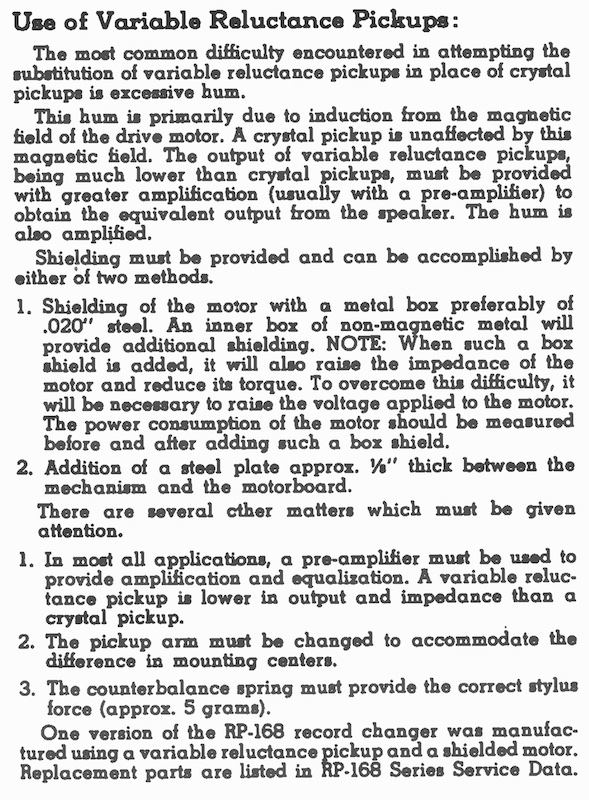
source: Supplementary Information: RP-168 Series and RP-190 Series Record Changers; Use of Variable Reluctance Pickups, Service Data (1949 No. 5), RCA Victor Service Data, Volume VI, 1950, p.XI.
RP-168 / RP-190 シリーズでバリレラカートリッジに交換する際の注意点。モータをシールドしてハムノイズを軽減すること、増幅および再生EQのためにプリアンプを使用すること、など。
13.4 The summary of what I got this time / 自分なりのまとめ
今回もながい記事となってしまいました。
Again, this Pt.13 became the extremely lengthy article, but anyway here it is.
さてさて、今回の内容をざっくりまとめると、こんな感じでしょうか。
…so, the rough summary of my understanding in this Pt.13 article would be something like this:
1949年1月9日、Columbia が 33 1/3回転かつ7インチの新メディアを発表。翌日の1月10日には RCA Victor が開発コードネーム「Madame X」、45回転7インチの新メディアと専用オートチェンジャーを発表。ともに従来の10インチ/12インチシェラック盤の代替を目指したメディアであった。7インチ/10インチ/12インチ 33 1/3回転の Columbia LP と、7インチ45回転盤との間で「回転数競争」の幕が切って落とされた。
On January 9, 1949, Columbia introduced another new format — 7-inch 33 1/3 rpm record. On the next day (January 10), RCA Victor officially unveiled its new format, 7-inch 45 rpm record and record changer system, code-named “Madame X”. This was the start of “Battle of the Speeds”, between Columbia’s 33 1/3 rpm (7/10/12-inches) and RCA Victor’s 45 rpm (7 inch).
7インチ盤は、長時間再生を犠牲にした代わりに、コンパクトなオートチェンジャーにより迅速な連続再生を売りにした。また大きなセンタースピンドルにより、内側からレコードを支えられる(結果、オートチェンジャー自体の寸法が小さくできる)メリット、そして盤に使用するヴァイナル化合物を減らせ廉価に製造可能なメリットがうたわれた。
RCA Victor’s 7-incher gave up long-playing feature, while it enabled continuous playing with compact auto-changer machines. Use of large spindle holes enabled the changer machine to hold the stacked records inside the spindle (thus the changer being compact); also the use of large spindle holes was for reducing raw material cost of pressing records.
結局、1950年4月には RCA Victor が 33 1/3回転長時間盤をリリース、1950年8月には Columbia が 45回転盤をリリースし、2種類のメディアが棲み分けることで落ち着いた。その後、7インチLPは1951年にフェードアウトし、45回転アルバムも1950年代半ばにはフェードアウトした。
The battle between two companies finally settled down after RCA Victor started releasing 33 1/3 rpm long playing records in April 1950 and Columbia started releasing 45 rpm singles in August 1950. Then Columbia’s 7-inch LP faded out in 1951; 45 rpm albums also faded out around mid-1950s.
RCA Victor が 45回転盤用に使用した録音特性(録音EQカーブ)は、のちの New Orthophonic(すなわち RIAA)に近いが、低域ブーストがなく、7〜8,000Hz より上はローパスフィルタで減衰されているというものだった。これは RCA Victor が当時 78回転盤向けに使っていたカーブと同じであった。
The recording characteristic (recording EQ curve) for RCA Victor’s 45 rpm records is so-called “Old Orthophonic”, which is basically similar to “New Orthophonic” (= RIAA), except it lacks the boost in the low-bass region, and high-frequency low-pass filter (about 7~8,000Hz and above) is applied. This characteristic was the same as the one used for RCA Victor’s 78rpm records at the time.
次回は、他のレーベルの動向、そして Audio Engineering Society から提案された、史上初の民生用レコード向け「再生用」統一カーブについて学んでいきます。
My next post will feature the technological trends of other labels, as well as the first “Playback” Standardization for commercial records, suggested by the Audio Engineering Society.
» 続き / Sequel: “Things I learned on Phono EQ curves, Pt.14” »

